
List of pharaohs
Encyclopedia
This article contains a list of the pharaoh
s of Ancient Egypt
, from the Early Dynastic Period
before 3000 BC through to the end of the Ptolemaic Dynasty
, when Egypt
became a province of Rome
under Augustus Caesar in 30 BC
.
Note that the dates given are approximate. The list of pharaohs presented below is based on the conventional chronology of Ancient Egypt, mostly based on the Digital Egypt for Universities database developed by the Petrie Museum of Egyptian Archaeology, but alternative dates taken from other authorities may be indicated separately.
Archibald Sayce
gave comparative data on several of these lists in his book The Ancient Empires of the East (1884), in addition to the lists found in Herodotus
, Diodorus, Eratosthenes
, and even a fanciful list found in "the Arabic writers". Yet another fanciful list that does not appear in Sayce, is found in the Book of Sothis
that George Syncellus
attributed to Manetho.
These god kings are followed by differing sets of semi-divine rulers.
, when Lower Egypt
and Upper Egypt
were ruled as separate kingdoms, and the First
and Second Dynasties
, known as the Black Land, consisted of the northern Nile
and the Nile Delta
. The following list may not be complete:
, known as the Red Land, consisted of the southern Nile and the desert
s. The following list may not be complete (there are many more of uncertain existence):
ruled from approximately 3050 BC
to 2890 BC, by some chronological schemes. (There are no precise or agreed-upon year dates for any of the Old or Middle Kingdom periods, and reign estimates differ widely from one Egyptologist to the next.)
ruled c. 2890 — 2686 BC.
through the Sixth Dynasty
(2686–2181 BC). Many Egyptologists also include the Memphite Seventh and Eighth Dynasties in the Old Kingdom as a continuation of the administration centralised at Memphis
. The Old Kingdom was followed by a period of disunity and relative cultural decline referred to by Egyptologists as the First Intermediate Period -- or, as the Egyptians called it, the "first illness."
The royal capital of Egypt during the Old Kingdom was located at Memphis
, where Djoser
established his court. The Old Kingdom is perhaps best known, however, for the large number of pyramid
s which were constructed at this time as pharaonic burial places. For this reason, the Old Kingdom is frequently referred to as "the Age of the Pyramids".
ruled from 2686 to 2613 BC.
ruled from 2613 to 2498 BC and included the pharaohs who had the Great Pyramids built, Khufu (Cheops), Khafra
(Chephren) and Menkaura
(Mycerinus).
ruled from 2498 to 2345 BC.
ruled from 2345 to 2181 BC.
and the advent of the Middle Kingdom
.
The Old Kingdom
rapidly collapsed after the death of Pepi II
. He had reigned for 94 years, longer than any monarch in history, and died aged 100. The latter years of his reign were marked by inefficiency because of his advanced age.
The Union of the Two Kingdoms fell apart and regional leaders had to cope with the resulting famine
.
Around 2160 BC, a new line of pharaohs tried to reunite Lower Egypt
from their capital in Herakleopolis Magna
. In the meantime, a rival line based at Thebes
was reuniting Upper Egypt
and a clash between the two rival dynasties was inevitable.
Around 2055 BC, a descendant of the pharaoh Intef III
defeated the Herakleopolitan pharaohs, reunited the Two Lands, founded the Eleventh Dynasty
and ruled as Mentuhotep II
, the first pharaoh of the Middle Kingdom.
(This table is based on the Abydos Table from the Temple of Seti I, taken from www.narmer.pl/main/abydos_en.html)
ruled from 2160 to 2130 BC. The Turin King List
has 18 kings reigning in the Ninth and Tenth Dynasties. Of these, twelve names are missing and four are partial.
was a local group that held sway over Lower Egypt
that ruled from 2130 to 2040 BC.
was a local group with roots in Upper Egypt
that ruled from 2134 to 1991 BC.
(2060-1802 BC) is the period from the end of the First Intermediate Period to the beginning of the Second Intermediate Period. In addition to the Twelfth Dynasty
, some scholars include the Eleventh
, Thirteenth
and Fourteenth Dynasties
in the Middle Kingdom. The Middle Kingdom can be noted for the expansion of trade outside of the kingdom that occurred during this time. This opening of trade eventually led to the downfall of the Middle Kingdom, induced by an invasion from the Hyksos
.
is considered to be part of the Middle Kingdom of Egypt.
ruled from 1991 to 1802 BC, and is considered by later Egyptians to have been their greatest dynasty.
, and the start of the New Kingdom. It is best known as when the Hyksos
, whose reign comprised the Fifteenth
and Sixteenth Dynasties
, made their appearance in Egypt.
The Thirteenth Dynasty
was much weaker than the Twelfth Dynasty
, and was unable to hold onto the long land of Egypt. The provincial ruling family in Xois
, located in the marshes of the western Delta, broke away from the central authority to form the Fourteenth Dynasty
.
The Hyksos made their first appearance during the reign of Sobekhotep IV
, and around 1720 BC took control of the town of Avaris
(the modern Tell el-Dab'a
/Khata'na). The Hyksos, led by Salitis
, the founder of the Fifteenth Dynasty, overran Egypt during the reign of Dedumose I.
Around the time Memphis
fell to the Hyksos, the native Egyptian ruling house in Thebes
declared its independence and set itself up as the Seventeenth Dynasty
. This dynasty eventually drove the Hyksos back into Asia
(following the Turin King List
) ruled from 1802 to around 1649 BC and lasted 153 or 154 Yrs according to Manetho. This table should be contrasted with Known kings of the 13th Dynasty
The position of the following kings is uncertain:
was a local group from the eastern Delta, based at Xois
, that ruled from around 1705 to around 1690 BC.
The position of the following pharaohs are uncertain:
The Turin King List
provides an additional 25 names, some fragmentary, and no dates. None are attested to elsewhere, and all are of very dubious provenance.
arose from among the Hyksos
people who emerged out of the Fertile Crescent
to establish a short-lived governance over much of the Nile region, and ruled from 1674 to 1535 BC.
was a local native kingdom from Thebes who ruled Egypt for between 80 and 100 years, according to Kim Ryholt
.
Some sources include as many as six more names –
was based in Upper Egypt
and ruled from 1650 to 1550 BC:
, Nineteenth
, and Twentieth dynasty of Egypt
, from the 16th century BC
to the 11th century BC
, between the Second Intermediate Period, and the Third Intermediate Period.
Through military dominance abroad, the New Kingdom saw Egypt's greatest territorial extent. It expanded far into Nubia
in the south, and held wide territories in the Near East
. Egyptian armies fought with Hittite
armies for control of modern-day Syria
.
Two of the best known pharaohs of the New Kingdom are Akhenaten
, also known as Amenhotep IV, whose exclusive worship of the Aten
is often interpreted as the first instance of monotheism
, and Ramesses II
, who attempted to recover the territories in modern Israel/Palestine, Lebanon
and Syria
that had been held in the Eighteenth Dynasty. His reconquest led to the Battle of Qadesh, where he led the Egyptian armies against the army of the Hittite king Muwatalli II
.
ruled from c. 1550 to 1292 BC:
ruled from 1292
to 1186 BC and includes one of the greatest pharaohs: Rameses II the Great:
ruled from 1190 to 1077 BC:
n origin ruled, giving this period its alternative name of the Libyan Period.
was based at Tanis
and was a relatively weak group. Theoretically, they were rulers of all Egypt, but in practice their influence was limited to Lower Egypt. They ruled from 1069 to 943 BC
were Libya
ns, ruling from around 943 to 720 BC:
was a local group, again of Libya
n origin, based at Herakleopolis and Thebes that ruled from 837 to c.735 BC:
were yet another group of western nomads (Libya
ns) who occupied the western Delta from 805 to 732 BC.
was a short-lived rival dynasty located in the western Delta (Sais
), with only two Pharaoh ruling from 732 to 720 BC.
runs from 732 BC to Egypt becoming a province of Rome
in 30 BC
, and includes periods of rule by Nubia
ns, Persians, and Macedon
ians.
ns invaded Egypt in 732 BC and took the throne of Egypt, establishing the Twenty-fifth Dynasty
which ruled until 656 BC.
They were ultimately driven back into Nubia, where they established a kingdom at Napata
(656-590), and, later, at Meroë
(590 BC-4th cent. AD).
ruled from around 672 to 525 BC.
. The Achaemenid shah
s were acknowledged as pharaohs in this era, forming a "Twenty-seventh" Dynasty
:
lasted only 6 years, from 404
to 398 BC
, with one Pharaoh:
ruled from 398
to 380 BC
:
ruled from 380
until Egypt once more came under Persian rule in 343 BC
:
, the Persian rulers from 343
to 332 BC
are occasionally designated as the Thirty-first Dynasty
:
ians under Alexander the Great ushered in the Hellenistic period with his conquest of Persia and Egypt. The Argeads
ruled from 332
to 309 BC
:
ruled Egypt from 305 BC
until Egypt became a province of Rome
in 30 BC
(whenever two dates overlap, that means there was a co-regency). The most famous member of this dynasty was Cleopatra VII, who in modern times is known simply as Cleopatra, and who had affairs with Mark Antony
and Julius Caesar
.
s with Roman Dictator Julius Caesar
and Roman General Marc Antony, but it was not until after her suicide in 30 BC (after Marc Antony was defeated by Octavian
, who would later be the emperor Augustus) that Egypt became a province of Rome
in 30 BC
.
Subsequent Roman Emperors were accorded the title of Pharaoh, although exclusively while in Egypt. One Egyptian king-list lists the Roman Emperors as Pharaohs up to and including Decius
. See the list of Roman emperors.
Pharaoh
Pharaoh is a title used in many modern discussions of the ancient Egyptian rulers of all periods. The title originates in the term "pr-aa" which means "great house" and describes the royal palace...
s of Ancient Egypt
Ancient Egypt
Ancient Egypt was an ancient civilization of Northeastern Africa, concentrated along the lower reaches of the Nile River in what is now the modern country of Egypt. Egyptian civilization coalesced around 3150 BC with the political unification of Upper and Lower Egypt under the first pharaoh...
, from the Early Dynastic Period
Early Dynastic Period of Egypt
The Archaic or Early Dynastic Period of Egypt immediately follows the unification of Lower and Upper Egypt c. 3100 BC. It is generally taken to include the First and Second Dynasties, lasting from the Protodynastic Period of Egypt until about 2686 BC, or the beginning of the Old Kingdom...
before 3000 BC through to the end of the Ptolemaic Dynasty
Ptolemaic dynasty
The Ptolemaic dynasty, was a Macedonian Greek royal family which ruled the Ptolemaic Empire in Egypt during the Hellenistic period. Their rule lasted for 275 years, from 305 BC to 30 BC...
, when Egypt
Egypt
Egypt , officially the Arab Republic of Egypt, Arabic: , is a country mainly in North Africa, with the Sinai Peninsula forming a land bridge in Southwest Asia. Egypt is thus a transcontinental country, and a major power in Africa, the Mediterranean Basin, the Middle East and the Muslim world...
became a province of Rome
Ancient Rome
Ancient Rome was a thriving civilization that grew on the Italian Peninsula as early as the 8th century BC. Located along the Mediterranean Sea and centered on the city of Rome, it expanded to one of the largest empires in the ancient world....
under Augustus Caesar in 30 BC
30 BC
Year 30 BC was either a common year starting on Wednesday, Thursday or Friday or a leap year starting on Thursday of the Julian calendar and a common year starting on Wednesday of the Proleptic Julian calendar...
.
Note that the dates given are approximate. The list of pharaohs presented below is based on the conventional chronology of Ancient Egypt, mostly based on the Digital Egypt for Universities database developed by the Petrie Museum of Egyptian Archaeology, but alternative dates taken from other authorities may be indicated separately.
Existing primary old lists of pharaohs
The texts of existing primary old lists of pharaohs are incomplete:- Palermo stonePalermo stoneThe Palermo Stone is a large fragment of a stele known as the Royal Annals of the Old Kingdom of Ancient Egypt. It contains records of the kings of Egypt from the first dynasty through the fifth dynasty....
- Turin Royal Canon
- ManethoManethoManetho was an Egyptian historian and priest from Sebennytos who lived during the Ptolemaic era, approximately during the 3rd century BC. Manetho wrote the Aegyptiaca...
's Aegyptiaca (History of Egypt) - Abydos King ListAbydos King ListThe Abydos King List, also called the Abydos Table is a list of the names of seventy-six kings and pharaohs of Ancient Egypt, found on the walls of the Temple of Seti I at Abydos, Egypt. It consists of three rows of thirty-eight cartouches on each row...
- Karnak TabletKarnak king listThe Karnak king list was located in the southwest corner of the Akh-Menu Hall. Composed during the reign of Thutmose III, it lists sixty-one kings beginning with Sneferu from Egypt's Old Kingdom...
- South Saqqara StoneSouth Saqqara StoneThe South Saqqara Stone is the lid of the sarcophagus of the ancient Egyptian queen Ankhenespepi which was inscribed with a list for the reigns of the pharaohs of the 6th dynasty from Teti, Userkare, Pepi I, Merenre to the early years of Pepi II under whom the document was likely created...
(discovered 1923, includes dyn. 6) - Saqqara TabletSaqqara TabletThe Saqqara Tablet in the Egyptian Museum contains one of several lists of Egyptian pharaohs surviving from the Ramesside Period. It was found in 1861 in the Saqqara tomb of Tjenry , an official of Ramesses II.The inscription lists 58 kings from Anedjib and Qa'a to Ramesses II...
(discovered 1861, includes dyn. 1-12)
Archibald Sayce
Archibald Sayce
The Rev. Archibald Henry Sayce , was a pioneer British Assyriologist and linguist, who held a chair as Professor of Assyriology at the University of Oxford from 1891 to 1919.- Life :...
gave comparative data on several of these lists in his book The Ancient Empires of the East (1884), in addition to the lists found in Herodotus
Herodotus
Herodotus was an ancient Greek historian who was born in Halicarnassus, Caria and lived in the 5th century BC . He has been called the "Father of History", and was the first historian known to collect his materials systematically, test their accuracy to a certain extent and arrange them in a...
, Diodorus, Eratosthenes
Eratosthenes
Eratosthenes of Cyrene was a Greek mathematician, poet, athlete, geographer, astronomer, and music theorist.He was the first person to use the word "geography" and invented the discipline of geography as we understand it...
, and even a fanciful list found in "the Arabic writers". Yet another fanciful list that does not appear in Sayce, is found in the Book of Sothis
Book of Sothis
The Book of Sothis is a document known mainly through transmission by George Syncellus, purporting to have been written by the historian Manetho. Modern scholars are nearly unanimous that the book was in fact written by someone other than Manetho, making it a forgery...
that George Syncellus
George Syncellus
George Syncellus was a Byzantine chronicler and ecclesiastic. He had lived many years in Palestine as a monk, before coming to Constantinople, where he was appointed syncellus to Tarasius, patriarch of Constantinople...
attributed to Manetho.
Legendary period
In the texts of the Palermo, Turin and Manetho king lists, there are different versions of names of eight god kings that ruled Egypt in the beginning.| Turin King List Turin King List The Turin King List, also known as the Turin Royal Canon, is a hieratic papyrus thought to date from the reign of Ramesses II, now in the Museo Egizio at Turin... |
Manetho Manetho Manetho was an Egyptian historian and priest from Sebennytos who lived during the Ptolemaic era, approximately during the 3rd century BC. Manetho wrote the Aegyptiaca... (Egyptian equivalent) |
Function |
|---|---|---|
| Ptah | Hephaistos (Ptah Ptah In Ancient Egyptian Religion, Ptah was the deification of the primordial mound in the Ennead cosmogony, which was more literally referred to as Ta-tenen , meaning risen land, or as Tanen, meaning submerged land, though Tatenen was a god in his... ) |
Craftsmen |
| Ra Ra Ra is the ancient Egyptian sun god. By the Fifth Dynasty he had become a major deity in ancient Egyptian religion, identified primarily with the mid-day sun... |
Helios Helios Helios was the personification of the Sun in Greek mythology. Homer often calls him simply Titan or Hyperion, while Hesiod and the Homeric Hymn separate him as a son of the Titans Hyperion and Theia or Euryphaessa and brother of the goddesses Selene, the moon, and Eos, the dawn... (Ra) |
Sun |
| - | Sosis or Agathosdaimon Agathodaemon In ancient Greek religion, Agathos Daimon or Agathodaemon was a daemon or presiding spirit of the vineyards and grainfields and a personal companion spirit, similar to the Roman genius, ensuring good luck, health, and wisdom.... (perhaps Sothis Sothis Sothis is the name of a star that the Egyptians considered unusually significant. The star is not explicitly identified, but there are enough clues for modern scholars to be almost unanimous in identifying Sothis as Sirius.... ?) (Shu Shu (Egyptian deity) In Egyptian mythology, Shu is one of the primordial gods, a personification of air, one of the Ennead of Heliopolis. He was created by Atum, his father and Iusaaset, his mother in the city of Heliopolis. With his sister, Tefnut , he was the father of Nut and Geb... ) |
Air |
| Geb Geb Geb was the Egyptian god of the Earth and a member of the Ennead of Heliopolis. It was believed in ancient Egypt that Geb's laughter was earthquakes and that he allowed crops to grow. The name was pronounced as such from the Greek period onward,... |
Kronos Kronos Kronos can refer to:*Cronus, a Titan, the father of Zeus, Poseidon, Hades, Hestia, Demeter, Hera, and Chiron.In business*Kronos Foods, the world's largest manufacturer of gyrosIn computing... (Geb) |
Earth |
| Osiris Osiris Osiris is an Egyptian god, usually identified as the god of the afterlife, the underworld and the dead. He is classically depicted as a green-skinned man with a pharaoh's beard, partially mummy-wrapped at the legs, wearing a distinctive crown with two large ostrich feathers at either side, and... |
Osiris Osiris Osiris is an Egyptian god, usually identified as the god of the afterlife, the underworld and the dead. He is classically depicted as a green-skinned man with a pharaoh's beard, partially mummy-wrapped at the legs, wearing a distinctive crown with two large ostrich feathers at either side, and... |
Afterlife |
| Set Set (mythology) Set was in Ancient Egyptian religion, a god of the desert, storms, and foreigners. In later myths he was also the god of darkness, and chaos... |
Typhon Typhon Typhon , also Typhoeus , Typhaon or Typhos was the last son of Gaia, fathered by Tartarus, and the most deadly monster of Greek mythology. He was known as the "Father of all monsters"; his wife Echidna was likewise the "Mother of All Monsters."Typhon was described in pseudo-Apollodorus,... (Set) |
Evil |
| Horus Horus Horus is one of the oldest and most significant deities in the Ancient Egyptian religion, who was worshipped from at least the late Predynastic period through to Greco-Roman times. Different forms of Horus are recorded in history and these are treated as distinct gods by Egyptologists... |
Horus Horus Horus is one of the oldest and most significant deities in the Ancient Egyptian religion, who was worshipped from at least the late Predynastic period through to Greco-Roman times. Different forms of Horus are recorded in history and these are treated as distinct gods by Egyptologists... |
War |
| Thoth Thoth Thoth was considered one of the more important deities of the Egyptian pantheon. In art, he was often depicted as a man with the head of an ibis or a baboon, animals sacred to him. His feminine counterpart was Seshat... |
Knowledge | |
| Ma'at | Order |
These god kings are followed by differing sets of semi-divine rulers.
| Turin King List Turin King List The Turin King List, also known as the Turin Royal Canon, is a hieratic papyrus thought to date from the reign of Ramesses II, now in the Museo Egizio at Turin... |
Length | Manetho Manetho Manetho was an Egyptian historian and priest from Sebennytos who lived during the Ptolemaic era, approximately during the 3rd century BC. Manetho wrote the Aegyptiaca... |
Length |
|---|---|---|---|
| Second dynasty of gods | unknown | Dynasty of Halfgods | unknown |
| 3 Achu-Dynasties | unknown | 30 Kings from Memphis | 1790 years |
| Dynasty of Disciples of Horus Horus Horus is one of the oldest and most significant deities in the Ancient Egyptian religion, who was worshipped from at least the late Predynastic period through to Greco-Roman times. Different forms of Horus are recorded in history and these are treated as distinct gods by Egyptologists... |
unknown | 10 Kings from This | 350 years |
Archaic period
The Archaic period includes the Early Dynastic PeriodEarly Dynastic Period of Egypt
The Archaic or Early Dynastic Period of Egypt immediately follows the unification of Lower and Upper Egypt c. 3100 BC. It is generally taken to include the First and Second Dynasties, lasting from the Protodynastic Period of Egypt until about 2686 BC, or the beginning of the Old Kingdom...
, when Lower Egypt
Lower Egypt
Lower Egypt is the northern-most section of Egypt. It refers to the fertile Nile Delta region, which stretches from the area between El-Aiyat and Zawyet Dahshur, south of modern-day Cairo, and the Mediterranean Sea....
and Upper Egypt
Upper Egypt
Upper Egypt is the strip of land, on both sides of the Nile valley, that extends from the cataract boundaries of modern-day Aswan north to the area between El-Ayait and Zawyet Dahshur . The northern section of Upper Egypt, between El-Ayait and Sohag is sometimes known as Middle Egypt...
were ruled as separate kingdoms, and the First
First dynasty of Egypt
The first dynasty of Ancient Egypt is often combined with the Dynasty II under the group title, Early Dynastic Period of Egypt...
and Second Dynasties
Second dynasty of Egypt
The second dynasty of ancient Egypt is often combined with Dynasty I under the group title Early Dynastic Period. It dates approximately from 2890 to 2686 BC. The capital at that time was Thinis.-Rulers:...
Early Dynastic: Lower Egypt
Lower EgyptLower Egypt
Lower Egypt is the northern-most section of Egypt. It refers to the fertile Nile Delta region, which stretches from the area between El-Aiyat and Zawyet Dahshur, south of modern-day Cairo, and the Mediterranean Sea....
, known as the Black Land, consisted of the northern Nile
Nile
The Nile is a major north-flowing river in North Africa, generally regarded as the longest river in the world. It is long. It runs through the ten countries of Sudan, South Sudan, Burundi, Rwanda, Democratic Republic of the Congo, Tanzania, Kenya, Ethiopia, Uganda and Egypt.The Nile has two major...
and the Nile Delta
River delta
A delta is a landform that is formed at the mouth of a river where that river flows into an ocean, sea, estuary, lake, reservoir, flat arid area, or another river. Deltas are formed from the deposition of the sediment carried by the river as the flow leaves the mouth of the river...
. The following list may not be complete:
| Name | Comments | Dates |
|---|---|---|
| Hsekiu Hsekiu Hsekiu, also Seka, was a Predynastic ancient Egyptian king who ruled in the Nile Delta. He is mentioned in the Palermo Stone inscriptions among a list of a small number of kings of Lower Egypt.-References:... |
Only known from the Palermo stone Palermo stone The Palermo Stone is a large fragment of a stele known as the Royal Annals of the Old Kingdom of Ancient Egypt. It contains records of the kings of Egypt from the first dynasty through the fifth dynasty.... |
? |
| Khayu Khayu Khayu was a Predynastic ancient Egyptian king who ruled in the Nile Delta. He is mentioned in the Palermo Stone inscriptions among a list of a small number of kings of Lower Egypt.-References:... |
Only known from the Palermo stone Palermo stone The Palermo Stone is a large fragment of a stele known as the Royal Annals of the Old Kingdom of Ancient Egypt. It contains records of the kings of Egypt from the first dynasty through the fifth dynasty.... |
? |
| Tiu Tiu (pharaoh) Tiu, also known as Teyew, was a Predynastic ancient Egyptian king who ruled in the Nile Delta. He is mentioned in the Palermo Stone inscriptions along with a small number of kings of Lower Egypt. Nothing else is known of his life or reign.-References:... |
Only known from the Palermo stone Palermo stone The Palermo Stone is a large fragment of a stele known as the Royal Annals of the Old Kingdom of Ancient Egypt. It contains records of the kings of Egypt from the first dynasty through the fifth dynasty.... |
? |
| Thesh Thesh Thesh, also known as Tjesh and Tesh, was a Predynastic ancient Egyptian king who ruled in the Nile Delta. He is mentioned in the Palermo Stone inscriptions among a small number of kings of Lower Egypt.-References:... |
Only known from the Palermo stone Palermo stone The Palermo Stone is a large fragment of a stele known as the Royal Annals of the Old Kingdom of Ancient Egypt. It contains records of the kings of Egypt from the first dynasty through the fifth dynasty.... |
? |
| Neheb Neheb Neheb was a Predynastic ancient Egyptian king who ruled in the Nile Delta. He is mentioned in the Palermo Stone inscriptions among a small number of kings of Lower Egypt.-References:... |
Only known from the Palermo stone Palermo stone The Palermo Stone is a large fragment of a stele known as the Royal Annals of the Old Kingdom of Ancient Egypt. It contains records of the kings of Egypt from the first dynasty through the fifth dynasty.... |
? |
| Wazner Wazner Wazner, also Wazenez or Wadjenedj , was a Predynastic Egyptian king who ruled in the Nile Delta. He is mentioned in the Palermo Stone inscriptions among a small number of kings of Lower Egypt.-References:... |
Only known from the Palermo stone Palermo stone The Palermo Stone is a large fragment of a stele known as the Royal Annals of the Old Kingdom of Ancient Egypt. It contains records of the kings of Egypt from the first dynasty through the fifth dynasty.... |
c. 3100 BC 31st century BC -Events:*c. 3100 BC: Narmer unifies Upper and Lower Egypt into one country; he rules this new country from Memphis.*c. 3100 BC: Narmer, pharaoh, rules .)... ? |
| Mekh Mekh Mekh was a Predynastic ancient Egyptian king who ruled in the Nile Delta. He is mentioned in the Palermo Stone inscriptions among a small number of kings of Lower Egypt.-References:... |
Only known from the Palermo stone Palermo stone The Palermo Stone is a large fragment of a stele known as the Royal Annals of the Old Kingdom of Ancient Egypt. It contains records of the kings of Egypt from the first dynasty through the fifth dynasty.... |
? |
Early Dynastic: Upper Egypt
Upper EgyptUpper Egypt
Upper Egypt is the strip of land, on both sides of the Nile valley, that extends from the cataract boundaries of modern-day Aswan north to the area between El-Ayait and Zawyet Dahshur . The northern section of Upper Egypt, between El-Ayait and Sohag is sometimes known as Middle Egypt...
, known as the Red Land, consisted of the southern Nile and the desert
Desert
A desert is a landscape or region that receives an extremely low amount of precipitation, less than enough to support growth of most plants. Most deserts have an average annual precipitation of less than...
s. The following list may not be complete (there are many more of uncertain existence):
| Name | Comments | Dates |
|---|---|---|
| Scorpion I Scorpion I Scorpion I was the first of two kings so-named of Upper Egypt during the Protodynastic Period. His name may refer to the scorpion goddess Serket.... |
Oldest tomb at Umm el-Qa'ab Umm el-Qa'ab Umm el-Qa`āb is the necropolis of the Early Dynastic kings at Abydos, in Egypt. Its modern name means Mother of Pots, as the whole area is littered with the broken pot shards of offerings made in earlier times... had scorpion insignia |
c. 3200 BC? |
| Iry-Hor Iry-Hor Iry-Hor or Ro was a Predynastic pharaoh of ancient Egypt, although some archaeologists are doubtful of his existence. He was most likely Ka's immediate predecessor... |
kingship uncertain | c. 3150 BC? |
| Ka Ka (Pharaoh) Ka, also Sekhem Ka or Ka-Sekhen, was a Predynastic pharaoh of Upper Egypt.- Biography :Ka ruled over Abydos in the late 32nd or early 31st century BC, and was buried at Umm el-Qa'ab. He most likely was the immediate successor to Iry-Hor and was succeeded by Narmer... |
— | c. 3100 BC 31st century BC -Events:*c. 3100 BC: Narmer unifies Upper and Lower Egypt into one country; he rules this new country from Memphis.*c. 3100 BC: Narmer, pharaoh, rules .)... |
| King Scorpion King Scorpion Scorpion, or Selk, also King Scorpion or Scorpion II refers to the second of two kings so-named of Upper Egypt during the Protodynastic Period. Their names may refer to the scorpion goddess Serket... |
Potentially pronounced Serqet, but uncertain; possibly the same person as Narmer Narmer Narmer was an ancient Egyptian pharaoh of the Early Dynastic Period . He is thought to be the successor to the Protodynastic pharaohs Scorpion and/or Ka, and he is considered by some to be the unifier of Egypt and founder of the First Dynasty, and therefore the first pharaoh of unified Egypt.The... . |
c. 3100 BC 31st century BC -Events:*c. 3100 BC: Narmer unifies Upper and Lower Egypt into one country; he rules this new country from Memphis.*c. 3100 BC: Narmer, pharaoh, rules .)... |
| Narmer Narmer Narmer was an ancient Egyptian pharaoh of the Early Dynastic Period . He is thought to be the successor to the Protodynastic pharaohs Scorpion and/or Ka, and he is considered by some to be the unifier of Egypt and founder of the First Dynasty, and therefore the first pharaoh of unified Egypt.The... |
The king who combined Upper and Lower Egypt. | c. 3100 BC 31st century BC -Events:*c. 3100 BC: Narmer unifies Upper and Lower Egypt into one country; he rules this new country from Memphis.*c. 3100 BC: Narmer, pharaoh, rules .)... |
First Dynasty
The First DynastyFirst dynasty of Egypt
The first dynasty of Ancient Egypt is often combined with the Dynasty II under the group title, Early Dynastic Period of Egypt...
ruled from approximately 3050 BC
31st century BC
-Events:*c. 3100 BC: Narmer unifies Upper and Lower Egypt into one country; he rules this new country from Memphis.*c. 3100 BC: Narmer, pharaoh, rules .)...
to 2890 BC, by some chronological schemes. (There are no precise or agreed-upon year dates for any of the Old or Middle Kingdom periods, and reign estimates differ widely from one Egyptologist to the next.)
| Name | Comments | Dates |
|---|---|---|
| Menes Menes Menes was an ancient Egyptian pharaoh of the early dynastic period, credited by classical tradition with having united Upper and Lower Egypt, and as the founder of the first dynasty .... |
Potentially the same person as Narmer Narmer Narmer was an ancient Egyptian pharaoh of the Early Dynastic Period . He is thought to be the successor to the Protodynastic pharaohs Scorpion and/or Ka, and he is considered by some to be the unifier of Egypt and founder of the First Dynasty, and therefore the first pharaoh of unified Egypt.The... , Hor-Aha Hor-Aha Hor-Aha is considered the second pharaoh of the first dynasty of ancient Egypt in current Egyptology. He lived around the thirty-first century BC.- Name :... , Scorpion King, or any combination of the three. First known pharaoh in Egyptian history |
Contingent upon identity |
| Hor-Aha Hor-Aha Hor-Aha is considered the second pharaoh of the first dynasty of ancient Egypt in current Egyptology. He lived around the thirty-first century BC.- Name :... |
Arguably the unifier of Upper and Lower Egypt. | c. 3050 BC 31st century BC -Events:*c. 3100 BC: Narmer unifies Upper and Lower Egypt into one country; he rules this new country from Memphis.*c. 3100 BC: Narmer, pharaoh, rules .)... |
| Djer Djer Djer was the second or third pharaoh of the first dynasty of Egypt, which dates from approximately 3100 BC. Some scholars, however, debate whether the first pharaoh, Menes or Narmer, and Hor-Aha might have been different rulers. If they were separate rulers, this would make Djer the third pharaoh... |
— | 41 years |
| Djet Djet Djet, also known as Wadj, Zet, and Uadji , was the fourth Egyptian pharaoh of the first dynasty... |
— | 23 years |
| Merneith Merneith Merneith was a consort and a regent of Ancient Egypt during the first dynasty. She may have been a ruler of Egypt in her own right. The possibility is based on several official records. Her rule occurred the thirtieth century B.C., for an undetermined period of time... |
Regent Regent A regent, from the Latin regens "one who reigns", is a person selected to act as head of state because the ruler is a minor, not present, or debilitated. Currently there are only two ruling Regencies in the world, sovereign Liechtenstein and the Malaysian constitutive state of Terengganu... for Den |
— |
| Den Den (Pharaoh) Den, also known as Hor-Den, Dewen and Udimu, is the Horus name of an early Egyptian king who ruled during the 1st dynasty. He is the best archaeologically attested ruler of this period. Den is said to have brought prosperity to his realm and numerous innovations are attributed to his reign... |
— | 14 to 20.1 years |
| Anedjib Anedjib Anedjib, more correctly Adjib and also known as Hor-Anedjib, Hor-Adjib and Enezib, is the Horus name of an early Egyptian king who ruled during the 1st dynasty. The ancient Greek historian Manetho named him "Miebîdós" and credited him with a reign of 26 years, whilst the Royal Canon of Turin... |
— | 10 years |
| Semerkhet Semerkhet Semerkhet is the Horus name of an early Egyptian king who ruled during the 1st dynasty. This ruler became known through a tragic legend handed down by ancient Greek historian Manetho, who reported that a calamity of some sort occurred during Semerkhet's reign... |
— | 9 years |
| Qa'a Qa'a -Legacy:Qa'a had a fairly large tomb in Abydos which measures 98.5 X 75.5 feet or 30 X 23 meters. Manetho gives him a reign of 26 years in his Epitome if this ruler was a certain Biechenes. A long reign is supported by the large size of this ruler's burial site at Abydos... |
— | 2916?–2890 BC |
Second Dynasty
The Second DynastySecond dynasty of Egypt
The second dynasty of ancient Egypt is often combined with Dynasty I under the group title Early Dynastic Period. It dates approximately from 2890 to 2686 BC. The capital at that time was Thinis.-Rulers:...
ruled c. 2890 — 2686 BC.
| Name | Comments | Dates |
|---|---|---|
| Hotepsekhemwy Hotepsekhemwy Hotepsekhemwy is the Horus name of a early Egyptian king who was the founder of the 2nd dynasty. The exact length of his reign is not known; the Turin canon suggests an improbable 95 years while the ancient Greek Historian Manetho reports that the reign of "Boëthôs" lasted for 38 years... |
— | 38 years |
| Raneb Raneb Raneb is the Horus name of the second early Egyptian king of the 2nd dynasty. The exact length of his reign is unknown since the Turin canon is damaged and the year accounts are lost... |
— | 39 years |
| Nynetjer Nynetjer Nynetjer is the Horus name of the third early Egyptian king during the 2nd dynasty. The exact length of his reign is unknown. The Turin Canon suggests an improbable reign of 96 years and the ancient Greek historian Manetho suggested that Nynetjer's reign lasted 47 years... |
— | 40 years |
| Wneg Wneg Weneg , also written as Weneg-Nebti, is the Nebti name of an early Egyptian king, who ruled during the second dynasty. Although his chronological position is clear to Egyptologists, it is unclear for how long King Weneg ruled... |
— | 8 years |
| Senedj Senedj Senedj is the name of an early Egyptian king who may have ruled during the 2nd dynasty. His historical standing remains uncertain, as there are no contemporary records about Senedj. The earliest mention of his name appears during the 4th dynasty. The exact duration of Senedj´s reign is unknown... |
— | 20 years |
| Seth-Peribsen Seth-Peribsen Peribsen is the serekh name of an early Egyptian king who ruled during the 2nd dynasty. Unlike many other pharaohs of this dynasty, Peribsen is well-attested in the archaeological records... |
— | 17 years |
| Sekhemib-Perenmaat Sekhemib-Perenmaat Sekhemib, or Sekhemib-Perenma´at, is the horus name of an early Egyptian king who ruled during the 2nd dynasty. Similar to his predecessor Seth-Peribsen, Sekhemib is contemporarily well attested in archaeological records, but he doesn´t appear in any posthumous document... |
— | |
| Khasekhem(wy) Khasekhemwy Khasekhemwy was the fifth and final king of the Second dynasty of Egypt. Little is known of Khasekhemwy, other than that he led several significant military campaigns and built several monuments, still extant, mentioning war against the Northerners... |
?–2686 BC | 17 to 18 years |
Old Kingdom
The Old Kingdom is the period in the third millennium BC when Egypt attained its first continuous peak of civilisational complexity and achievement (the first of three so-called "Kingdom" periods which mark the high points of civilization in the Nile Valley), spanning the period when Egypt was ruled by the Third DynastyThird dynasty of Egypt
For the Sumerian Renaissance, see Third Dynasty of Ur.The Third Dynasty of ancient Egypt is the first dynasty of the Old Kingdom. Other dynasties of the Old Kingdom include the Fourth, Fifth and Sixth...
through the Sixth Dynasty
Sixth dynasty of Egypt
The sixth dynasty of ancient Egypt is often combined with Dynasties III, IV and V under the group title the Old Kingdom.-Pharaohs:...
(2686–2181 BC). Many Egyptologists also include the Memphite Seventh and Eighth Dynasties in the Old Kingdom as a continuation of the administration centralised at Memphis
Memphis, Egypt
Memphis was the ancient capital of Aneb-Hetch, the first nome of Lower Egypt. Its ruins are located near the town of Helwan, south of Cairo.According to legend related by Manetho, the city was founded by the pharaoh Menes around 3000 BC. Capital of Egypt during the Old Kingdom, it remained an...
. The Old Kingdom was followed by a period of disunity and relative cultural decline referred to by Egyptologists as the First Intermediate Period -- or, as the Egyptians called it, the "first illness."
The royal capital of Egypt during the Old Kingdom was located at Memphis
Memphis, Egypt
Memphis was the ancient capital of Aneb-Hetch, the first nome of Lower Egypt. Its ruins are located near the town of Helwan, south of Cairo.According to legend related by Manetho, the city was founded by the pharaoh Menes around 3000 BC. Capital of Egypt during the Old Kingdom, it remained an...
, where Djoser
Djoser
Netjerikhet or Djoser is the best-known pharaoh of the Third dynasty of Egypt. He commissioned his official, Imhotep, to build the first of the pyramids, a step pyramid for him at Saqqara...
established his court. The Old Kingdom is perhaps best known, however, for the large number of pyramid
Pyramid
A pyramid is a structure whose outer surfaces are triangular and converge at a single point. The base of a pyramid can be trilateral, quadrilateral, or any polygon shape, meaning that a pyramid has at least three triangular surfaces...
s which were constructed at this time as pharaonic burial places. For this reason, the Old Kingdom is frequently referred to as "the Age of the Pyramids".
Third Dynasty
The Third DynastyThird dynasty of Egypt
For the Sumerian Renaissance, see Third Dynasty of Ur.The Third Dynasty of ancient Egypt is the first dynasty of the Old Kingdom. Other dynasties of the Old Kingdom include the Fourth, Fifth and Sixth...
ruled from 2686 to 2613 BC.
| Name | Image | Comments | Dates |
|---|---|---|---|
| Sanakhte Sanakhte Sanakht, generally identified with the Nebka of much later king lists, was probably either the first or second pharaoh of the Third Dynasty of Ancient Egypt. The dates assigned to his reign by Shaw are ca. 2686-2667 BC; for various conjectures of other scholars, see the... |
 |
— | 2686-2668 |
| Djoser Djoser Netjerikhet or Djoser is the best-known pharaoh of the Third dynasty of Egypt. He commissioned his official, Imhotep, to build the first of the pyramids, a step pyramid for him at Saqqara... |
 |
Had the Step Pyramid Pyramid of Djoser The Pyramid of Djoser , or step pyramid is an archeological remain in the Saqqara necropolis, Egypt, northwest of the city of Memphis. It was built during the 27th century BC for the burial of Pharaoh Djoser by Imhotep, his vizier... constructed by Imhotep Imhotep Imhotep , fl. 27th century BC was an Egyptian polymath, who served under the Third Dynasty king Djoser as chancellor to the pharaoh and high priest of the sun god Ra at Heliopolis... |
2668–2649; Radiocarbon date start reign between 2691 and 2625 |
| Sekhemkhet Sekhemkhet Sekhemkhet was a Pharaoh in Egypt during the Third dynasty. According to the Manethonian tradition, a king known as Tyris reigned for a relatively brief period of seven years, and modern scholars believe Djoserty and Sekhemkhet are the same person... |
— | — | 2649–2643 |
| Khaba Khaba Khaba was a Pharaoh of Ancient Egypt's Old Kingdom and is generally considered to have reigned near the end of the Third Dynasty. He was successor to Sekhemkhet, and he was probably a son of Sekhemkhet... |
— | — | 2643–2637 |
| Huni Huni Huni was the last Pharaoh of Egypt of the Third dynasty. He was the successor to Khaba.-Family:Huni was the father of Hetepheres I, the wife of Sneferu who was the first king of the Fourth Dynasty... |
 |
— | 2637–2613 |
Fourth Dynasty
The Fourth DynastyFourth dynasty of Egypt
The fourth dynasty of ancient Egypt is characterized as a "golden age" of the Old Kingdom. Dynasty IV lasted from ca. 2613 to 2494 BC...
ruled from 2613 to 2498 BC and included the pharaohs who had the Great Pyramids built, Khufu (Cheops), Khafra
Khafra
Khafra — also Khafre — was an Egyptian pharaoh of the Fourth dynasty, who had his capital at Memphis. According to some authors he was the son and successor of Khufu, but it is more commonly accepted that Djedefre was Khufu's successor and Khafra was Djedefre's...
(Chephren) and Menkaura
Menkaura
Menkaure was a pharaoh of the Fourth dynasty of Egypt who ordered the construction of the third and smallest of the Pyramids of Giza. His name means "Eternal like the Souls of Re"...
(Mycerinus).
| Nomen (Praenomen) | Image | Comments | Dates |
|---|---|---|---|
| Sneferu Sneferu Sneferu, also spelled as Snephru, Snefru or Snofru , was the founder of the Fourth dynasty of Egypt. Estimates of his reign vary, with for instance The Oxford History of Ancient Egypt suggesting a reign from around 2613 BC to 2589 BC, a reign of 24 years, while Rolf Krauss suggests a 30-year reign... |
 |
Built the Bent Pyramid Bent Pyramid The Bent Pyramid is an ancient Egyptian pyramid located at the royal necropolis of Dahshur, approximately 40 kilometres south of Cairo, built under the Old Kingdom Pharaoh Sneferu... , which is a pyramid built at a normal angle at the bottom but drastically changes at the top. He also built the first "true" pyramid, known as the Red Pyramid Red Pyramid The Red Pyramid, also called the North Pyramid, is the largest of the three major pyramids located at the Dahshur necropolis. Named for the rusty reddish hue of its stones, it is also the third largest Egyptian pyramid, after those of Khufu and Khafra at Giza. At the time of its completion, it was... . Some say that he was buried at the Red Pyramid, while others say that he was buried at the Bent Pyramid. Bones have been found at the Red Pyramid, but there is no evidence that this is Sneferu's body. |
2613–2589 |
| Khufu | Greek form: Cheops. Built the great pyramid of Giza Great Pyramid of Giza The Great Pyramid of Giza is the oldest and largest of the three pyramids in the Giza Necropolis bordering what is now El Giza, Egypt. It is the oldest of the Seven Wonders of the Ancient World, and the only one to remain largely intact... . Note that Khufu is spoken of in early sources as being "third" of his family to rule, although there is no known record of a Pharaoh between Sneferu and Khufu. One supposition is that there might have been a very short reign of some elder brother of Khufu, whose inscriptions, name, and monuments have perished for one reason or another. |
2589–2566 | |
| Djedefra Djedefra Djedefre was an Egyptian pharaoh, the son and immediate successor of Khufu. The mother of Djedefre is unknown. His name means "Enduring like Re." Djedefre was the first king to use the title Son of Ra as part of his royal titulary, which is seen as an indication of the growing popularity of the... (Radjedef) |
Believed to have created the Great Sphinx of Giza Great Sphinx of Giza The Great Sphinx of Giza , commonly referred to as the Sphinx, is a limestone statue of a reclining or couchant sphinx that stands on the Giza Plateau on the west bank of the Nile in Giza, Egypt.... as a monument for his deceased father. He also created a pyramid at Abu Rawash however this pyramid is no longer intact as it is believed the Romans recycled the materials it was made from. Before being demolished by the Romans, according to a documentary aired by the History Channel, the pyramid may actually have been the highest ever built (about 20 meters taller than the Great Pyramid of Giza although this is due to its elevated location rather than the size from base to tip). |
2566–2558 | |
| Khafra Khafra Khafra — also Khafre — was an Egyptian pharaoh of the Fourth dynasty, who had his capital at Memphis. According to some authors he was the son and successor of Khufu, but it is more commonly accepted that Djedefre was Khufu's successor and Khafra was Djedefre's... |
 |
Greek form: Chephren His pyramid is the second largest in Giza. Built the Sphinx of Giza. | 2558–2532 |
| — | – | here some authorities insert Bikheris, following Manetho Manetho Manetho was an Egyptian historian and priest from Sebennytos who lived during the Ptolemaic era, approximately during the 3rd century BC. Manetho wrote the Aegyptiaca... |
— |
| Menkaura Menkaura Menkaure was a pharaoh of the Fourth dynasty of Egypt who ordered the construction of the third and smallest of the Pyramids of Giza. His name means "Eternal like the Souls of Re"... |
Greek form: Mycerinus. His pyramid is the third and smallest in Giza. | 2532–2503 | |
| Shepseskaf Shepseskaf Shepseskaf was a son of Menkaure who succeeded his father on the throne. Shepseskaf's name means "His Soul is Noble."- Family :Shepseskaf was a son of Menkaure and grandson of Khafra, but his mother's name is not known. His mother can be either Khamerernebty II or Rekhetre... |
 |
– | 2503–2498 |
| Djedefptah | – | – | — |
| – | – | here some authorities insert Thampthis, following Manetho | — |
Fifth Dynasty
The Fifth DynastyFifth dynasty of Egypt
The fifth dynasty of ancient Egypt is often combined with Dynasties III, IV and VI under the group title the Old Kingdom. Dynasty V dates approximately from 2494 to 2345 BC.-Rulers:...
ruled from 2498 to 2345 BC.
| Name | Image | Comments | Dates |
|---|---|---|---|
| Userkaf Userkaf Userkaf was the founder of the Fifth dynasty of Egypt and the first pharaoh to start the tradition of building sun temples at Abusir. His name means "his Ka is powerful". He ruled from 2494-2487 BC and constructed the Pyramid of Userkaf complex at Saqqara.- Family :Userkaf's wife was Queen... |
Buried in a pyramid in Saqqara Pyramid of Userkaf The Pyramid complex of Userkaf is located in the pyramid field at Saqqara. Constructed in dressed stone, with a core of rubble, the pyramid now resembles a conical hill just to the north of the Step Pyramid of Djoser Netjerikhet.-References:... |
2498–2491 | |
| Sahure Sahure - Etymology :Sahure's birth name means "He who is Close to Re". His Horus name was Nebkhau.- Biography :Sahure was a son of queen Neferhetepes, as shown in scenes from the causeway of Sahure's pyramid complex in Abusir. His father was Userkaf. Sahure's consort was queen Neferetnebty. Reliefs show... |
Moved the royal necropolis to Abusir Abusir Abusir is the name given to an Egyptian archaeological locality – specifically, an extensive necropolis of the Old Kingdom period, together with later additions – in the vicinity of the modern capital Cairo... |
2490–2477 | |
| Neferirkare Kakai Neferirkare Kakai Neferirkare Kakai was the third Pharaoh of Egypt during the Fifth dynasty. His praenomen, Neferirkare, means "Beautiful is the Soul of Ra". His Horus name was Userkhau, his Golden Horus name Sekhemunebu and his Nebti name Khaiemnebty.- Family :... |
— | 2477–2467 | |
| Shepseskare Isi Shepseskare Isi Shepseskare Isi, also spelt Shepseskare, , was a Pharaoh of Egypt during the Fifth dynasty, who is thought to have reigned from around 2455 to 2448 BC... |
— | 2467–2460 | |
| Neferefre Neferefre Neferefre was a Pharaoh of Egypt during the Fifth dynasty. His name means "Beautiful is Re" in Egyptian.-Family:Neferefre was the son of king Neferirkare Kakai by queen Khentkaus II, and the elder brother of pharaoh Nyuserre Ini.... |
— | 2460–2453 | |
| Nyuserre Ini Nyuserre Ini Nyuserre Ini , was a Pharaoh of Egypt during the Fifth dynasty. He is frequently given a reign of 24 or 25 years and is dated from ca. 2445 BC to 2421 BC. His prenomen, Nyuserre, means "Possessed of Re's Power"... |
 |
— | 2453–2422 |
| Menkauhor Kaiu Menkauhor Kaiu Menkauhor Kaiu , was a Pharaoh of the Fifth dynasty during the Old Kingdom. He was the successor of King Nyuserre Ini and was succeeded by Djedkare Isesi. Menkauhor's royal name or prenomen means "Eternal are the Souls of Horus".-Family:Menkauhor may have been a son of Nyuserre... |
— | 2422–2414 | |
| Djedkare Isesi Djedkare Isesi Djedkare Isesi in Greek known as Tancheres from Manetho's Aegyptiaca, was a Pharaoh of Egypt during the Fifth dynasty. He is assigned a reign of twenty-eight years by the Turin Canon although some Egyptologists believe this is an error and should rather be thirty-eight years... |
— | — | 2414–2375 |
| Unas Unas Unas was a Pharaoh of Ancient Egypt, and the last ruler of the Fifth dynasty from the Old Kingdom. His reign has been dated as falling between 2375 BC and 2345 BC... |
— | — | 2375–2345 |
Sixth Dynasty
The Sixth DynastySixth dynasty of Egypt
The sixth dynasty of ancient Egypt is often combined with Dynasties III, IV and V under the group title the Old Kingdom.-Pharaohs:...
ruled from 2345 to 2181 BC.
| Name | Comments | Dates |
|---|---|---|
| Teti Teti Teti, less commonly known as Othoes, was the first Pharaoh of the Sixth dynasty of Egypt and is buried at Saqqara. The exact length of his reign has been destroyed on the Turin King List, but is believed to have been about 12 years.-Biography:... |
— | 2345–2333 |
| Userkare Userkare Userkare was the second king of the Sixth Dynasty. He is generally seen as one of the leaders who opposed his predecessor, Teti's royal line and was most likely an usurper to the throne... |
— | 2333–2332 |
| Meryre Pepi I Pepi I Meryre Pepi I Meryre was the third king of the Sixth dynasty of Egypt. His first throne name was Neferdjahor which the king later altered to Meryre meaning "beloved of Rê."-Family:... |
— | 2332–2283 |
| Merenre Nemtyemsaf I Merenre Nemtyemsaf I Merenre Nemtyemsaf I was the fourth king of the Sixth dynasty of Egypt. His nomen, theophorically referring to Nemty, was formerly read as Antyemsaf, a reading now known to be incorrect.- Biography :... |
— | 2283–2278 |
| Neferkare Pepi II Pepi II Neferkare Pepi II was a pharaoh of the Sixth dynasty in Egypt's Old Kingdom. His throne name, Neferkare , means "Beautiful is the Ka of Re". He succeeded to the throne at age six, after the death of Merenre I, and is generally credited with having the longest reign of any monarch in history at 94 years... |
Possible unto 2224 which would explain the following 4 kings. | 2278–2184 |
| Neferka Neferka Neferka was an ancient Egyptian pharaoh, ruling during the Sixth dynasty. His reign lasted from about 2200 BC to 2199 BC.He is only mentioned in the Oxford Encyclopedia of Ancient Egypt. However, his reign lasted during the reign of Pepi II, suggesting that he may be his son or co-reigner.... |
Only mentioned in the Oxford Encyclopedia of Ancient Egypt. Reigned during Pepi II; was possibly his son or co-ruler. | 2200–2199 |
| Nefer Nefer - Definition :Nefer is a word in the Ancient Egyptian language that was used to symbolize beauty and goodness. The exact translation of the word in English is "Beautiful on the inside and the outside".-Hieroglyphs and Symbolism:... |
Reign of 2 years, 1 month and a day according to Turin Canon | 2197–2193 |
| Aba | Reigned for 4 years and 2 months. Reign dates do not follow Turin Canon. Highly unlikely. | 2193–2176 |
| Unknown king | Unknown king attested here | |
| Merenre Nemtyemsaf II Merenre Nemtyemsaf II Merenre Nemtyemsaf II was briefly Pharaoh of Egypt, likely succeeding his long-lived father Pepi II Neferkare. The Turin King List says that Merenre reigned for only a year, after succeeding his father Pepi II. His name is also mentioned on a stela that was discovered near the site of the pyramid... |
Uncertain pharaoh. | 2184 |
| Neitiqerty Siptah Neitiqerty Siptah The Ancient Egyptian king, Neitiqerty Siptah is an obscure successor to Merenre Nemtyemsaf II, towards the end of the Sixth dynasty of Egypt. His reign is usually replaced with that of Nitocris, the 'first female pharaoh', who seems not to have actually existed, as although it was claimed that... |
This king may have been confused in later years as a supposed female ruler Nitocris Nitocris Nitocris has been claimed to have been the last pharaoh of the Sixth Dynasty. Her name is found in the Histories of Herodotus and writings of Manetho but her historicity is questionable. She might have been an interregnum queen... . |
2184–2181 |
First Intermediate Period
The First Intermediate Period (2181-2160 BC) is the period between the end of the Old KingdomOld Kingdom
Old Kingdom is the name given to the period in the 3rd millennium BC when Egypt attained its first continuous peak of civilization in complexity and achievement – the first of three so-called "Kingdom" periods, which mark the high points of civilization in the lower Nile Valley .The term itself was...
and the advent of the Middle Kingdom
Middle Kingdom of Egypt
The Middle Kingdom of Egypt is the period in the history of ancient Egypt stretching from the establishment of the Eleventh Dynasty to the end of the Fourteenth Dynasty, between 2055 BC and 1650 BC, although some writers include the Thirteenth and Fourteenth dynasties in the Second Intermediate...
.
The Old Kingdom
Old Kingdom
Old Kingdom is the name given to the period in the 3rd millennium BC when Egypt attained its first continuous peak of civilization in complexity and achievement – the first of three so-called "Kingdom" periods, which mark the high points of civilization in the lower Nile Valley .The term itself was...
rapidly collapsed after the death of Pepi II
Pepi II Neferkare
Pepi II was a pharaoh of the Sixth dynasty in Egypt's Old Kingdom. His throne name, Neferkare , means "Beautiful is the Ka of Re". He succeeded to the throne at age six, after the death of Merenre I, and is generally credited with having the longest reign of any monarch in history at 94 years...
. He had reigned for 94 years, longer than any monarch in history, and died aged 100. The latter years of his reign were marked by inefficiency because of his advanced age.
The Union of the Two Kingdoms fell apart and regional leaders had to cope with the resulting famine
Famine
A famine is a widespread scarcity of food, caused by several factors including crop failure, overpopulation, or government policies. This phenomenon is usually accompanied or followed by regional malnutrition, starvation, epidemic, and increased mortality. Every continent in the world has...
.
Around 2160 BC, a new line of pharaohs tried to reunite Lower Egypt
Lower Egypt
Lower Egypt is the northern-most section of Egypt. It refers to the fertile Nile Delta region, which stretches from the area between El-Aiyat and Zawyet Dahshur, south of modern-day Cairo, and the Mediterranean Sea....
from their capital in Herakleopolis Magna
Herakleopolis Magna
Heracleopolis or Herakleopolis Magna is the Greek name of the capital of the Twentieth nome of ancient Egypt. It was called Henen-nesut, Nen-nesu, or Hwt-nen-nesu in ancient Egyptian, meaning 'house of the royal child.' Later, it was called Hnas in Coptic, and Ahnas in medieval Arabic writings...
. In the meantime, a rival line based at Thebes
Thebes, Egypt
Thebes is the Greek name for a city in Ancient Egypt located about 800 km south of the Mediterranean, on the east bank of the river Nile within the modern city of Luxor. The Theban Necropolis is situated nearby on the west bank of the Nile.-History:...
was reuniting Upper Egypt
Upper Egypt
Upper Egypt is the strip of land, on both sides of the Nile valley, that extends from the cataract boundaries of modern-day Aswan north to the area between El-Ayait and Zawyet Dahshur . The northern section of Upper Egypt, between El-Ayait and Sohag is sometimes known as Middle Egypt...
and a clash between the two rival dynasties was inevitable.
Around 2055 BC, a descendant of the pharaoh Intef III
Intef III
Intef III was a Pharaohin Egypt of the Eleventh Dynasty during the First Intermediate Period. His Horus name was Nakjtnebtepnefer, which translates to "Horus, the victorious one, Lord of the good beginning". He was buried in a saff-tomb at el-Tarif , and little is known about his deeds...
defeated the Herakleopolitan pharaohs, reunited the Two Lands, founded the Eleventh Dynasty
Eleventh dynasty of Egypt
The eleventh dynasty of ancient Egypt was one group of rulers, whose earlier members are grouped with the four preceding dynasties to form the First Intermediate Period, while the later members are considered part of the Middle Kingdom...
and ruled as Mentuhotep II
Mentuhotep II
Nebhepetre Mentuhotep II was a Pharaoh of the 11th dynasty, the son of Intef III of Egypt and a minor queen called Iah. His own wife was the 'king's mother' Tem. Other wives were Neferu and several secondary wives, one or more who it has been suggested were possibly Nubian, buried in his...
, the first pharaoh of the Middle Kingdom.
Seventh and Eighth Dynasties (combined)
The Seventh and Eighth Dynasties ruled from 2181 to 2160 BC.(This table is based on the Abydos Table from the Temple of Seti I, taken from www.narmer.pl/main/abydos_en.html)
| Name | Comments | Dates |
|---|---|---|
| Neferkara I Neferkara I Neferkara I is the cartouche name of a king who is said to have ruled during the 2nd dynasty of Ancient Egypt. The exact length of his reign is unknown since the Turin canon lacks the years of rulership and the ancient Greek historian Manetho suggests that Neferkara´s reign lasted 25 years... |
||
| Netjerkare Netjerkare Netjerkare may have been a king during the First Intermediate Period of Ancient Egypt. His existence is only clearly attested on the Abydos King List, where he occupies the 40th registry, as the successor to Merenre Nemtyemsaf II, skipping over the female king Nitocris... |
||
| Menkare Menkare Menkare may have been a king of the First Intermediate Period of Ancient Egypt. He is entirely unattested outside of the Abydos King List.-References:*, Accessed November 9, 2006.*, Accessed November 9, 2006.... |
||
| Neferkare II Neferkare II Neferkare II may have been a seventh dynasty king of ancient Egypt during the First Intermediate Period. His name is only attested on the Abydos King List, however J... |
||
| Neferkara Nebi Neferkare Neby Neferkare Neby may have been a king of the Seventh Dynasty of ancient Egypt during the First Intermediate Period. His name is clearly attested on the Abydos King List, and unlike other kings of this period, is attested in two other sources. His mother was apparently Queen Ankhesenpepi II, which... |
||
| Djedkara Shemai Djedkare Shemai Djedkare Shemai may have been a seventh dynasty king of ancient Egypt during the First Intermediate Period. His name is only attested on the Abydos King List.-References:*, Accessed November 9, 2006.*, Accessed November 9, 2006.... |
||
| Neferkara Khendu Neferkare Khendu Neferkare Khendu may have been a seventh dynasty king of Ancient Egypt during the First Intermediate Period. His name is only attested on the Abydos King List.-References:*, Accessed November 9, 2006.*, Accessed November 9, 2006.... |
||
| Some authorities place here Merenhor Merenhor Merenhor may have been a Seventh dynasty king of ancient Egypt during the First Intermediate Period. His name is only attested on the Abydos King List.-References:*, Accessed November 9, 2006.*, Accessed November 9, 2006.... |
||
| Neferkamin Seneferka Neferkamin Neferkamin may have been a seventh dynasty king of ancient Egypt during the First Intermediate Period. His throne name Sneferka is attested on the Abydos King List, however he also appears on a tablet in the British Museum with the name "Neferkamin".... |
||
| Nikara Nikare Nikare may have been a seventh dynasty king of ancient Egypt during the First Intermediate Period. His name is only attested on the Abydos King List.-References:*, Accessed November 9, 2006.*, Accessed November 9, 2006.... |
||
| Neferkara Tereru Neferkare Tereru Neferkare Tereru may have been a seventh dynasty king of ancient Egypt during the First Intermediate Period. His name is only attested on the Abydos King List.-References:*, Accessed November 9, 2006.*, Accessed November 9, 2006.... |
||
| Neferkahor Neferkahor Neferkahor may have been a seventh dynasty king of ancient Egypt during the First Intermediate Period. His name is only attested on the Abydos King List and on a cylinder seal.-References:*, Accessed November 9, 2006.*, Accessed November 9, 2006.... |
||
| Neferkara Pepyseneb Neferkare Pepiseneb Neferkare Pepiseneb may have been an eighth dynasty king of ancient Egypt during the First Intermediate Period. His name is attested on the Abydos King List, and he is the first king since ntyiqrt to appear on the Turin Canon of Kings, which gives him the epithet, Shery, or The Younger. It is... |
||
| Neferkamin Anu Neferkamin Anu Neferkamin Anu may have been an eighth dynasty king of ancient Egypt during the First Intermediate Period. His name is attested on the Abydos King List, and also in the Turin Canon of Kings. Neferkamin's reign length is lost in a lacuna in the Turin Canon.... |
||
| Qakare Ibi Qakare Ibi Qakare Ibi was an ancient Egyptian ruler of the 8th Dynasty. The name Qa-ka-Re means "strong is the soul of Re".His existence was established by the discovery of his small pyramid in South Saqqara which also continues the late Old Kingdom tradition of listing pyramid texts in his tomb. His name is... |
||
| 2169-2167 | ||
| Neferkara II Neferkaure II Neferkaure II was an eighth dynasty king of ancient Egypt during the First Intermediate Period. His name is attested on the Abydos King List, and also in the Turin Canon of Kings, which attributes him a rule of four years and two months... |
||
| 2167-2163 | ||
| Neferkawhor Khuwihap Neferkauhor Neferkauhor was an eighth dynasty king of Ancient Egypt during the First Intermediate Period. His name is attested on the Abydos King List as the penultimate king of the Old Kingdom, but not on the Turin Canon where his name is lost in a lacuna—although his reign length is preserved here... |
||
| 2163-2161 | ||
| Neferirkara Neferirkare *For the better known Fifth dynasty pharaoh by this name, see Neferirkare KakaiNeferirkare was an Eighth dynasty king of Ancient Egypt during the First Intermediate Period. His name is only clearly attested in the Abydos King List but it is assumed that the reign length figure for the last 8th... |
||
| 2161-2160 |
Ninth Dynasty
The Ninth DynastyNinth dynasty of Egypt
The ninth dynasty of ancient Egypt is often combined with Dynasties VII, VIII, X and XI under the group title First Intermediate Period...
ruled from 2160 to 2130 BC. The Turin King List
Turin King List
The Turin King List, also known as the Turin Royal Canon, is a hieratic papyrus thought to date from the reign of Ramesses II, now in the Museo Egizio at Turin...
has 18 kings reigning in the Ninth and Tenth Dynasties. Of these, twelve names are missing and four are partial.
| Name | Comments | Dates |
|---|---|---|
| — | Manetho Manetho Manetho was an Egyptian historian and priest from Sebennytos who lived during the Ptolemaic era, approximately during the 3rd century BC. Manetho wrote the Aegyptiaca... states that Achthoes founded this dynasty. |
2160– ? |
| — | - | ? |
| Neferkare III | - | ? |
| Khety (Acthoes II) | - | ? |
| Senenh— or Setut | - | ? |
| — | - | ? |
| Mer[ibre Khety] | - | ? |
| Shed— | - | ? |
| H— | - | ? |
Tenth Dynasty
The Tenth DynastyTenth dynasty of Egypt
The tenth dynasty of ancient Egypt is often combined with Dynasties VII, VIII, IX and XI under the group title First Intermediate Period...
was a local group that held sway over Lower Egypt
Lower Egypt
Lower Egypt is the northern-most section of Egypt. It refers to the fertile Nile Delta region, which stretches from the area between El-Aiyat and Zawyet Dahshur, south of modern-day Cairo, and the Mediterranean Sea....
that ruled from 2130 to 2040 BC.
| Name | Comments | Dates |
|---|---|---|
| Meryhathor | — | 2130– ? |
| Neferkare IV | — | ? |
| Wankare (Acthoes III) | — | ? |
| Merykare | — | ? –2040 |
Eleventh Dynasty
The Eleventh DynastyEleventh dynasty of Egypt
The eleventh dynasty of ancient Egypt was one group of rulers, whose earlier members are grouped with the four preceding dynasties to form the First Intermediate Period, while the later members are considered part of the Middle Kingdom...
was a local group with roots in Upper Egypt
Upper Egypt
Upper Egypt is the strip of land, on both sides of the Nile valley, that extends from the cataract boundaries of modern-day Aswan north to the area between El-Ayait and Zawyet Dahshur . The northern section of Upper Egypt, between El-Ayait and Sohag is sometimes known as Middle Egypt...
that ruled from 2134 to 1991 BC.
| Name | Comments | Dates |
|---|---|---|
| Mentuhotep I Mentuhotep I Mentuhotep I was a local Egyptian prince at Thebes during the First Intermediate Period. He became the first openly acknowledged ruler of the Eleventh dynasty by assuming the title of first "supreme chief of Upper Egypt" and, later, declaring himself king over all Egypt. He is named as a nomarch in... Tepy-a |
— | |
| Sehertawy Intef I Intef I Intef I was a local Egyptian ruler at Thebes, and a member of the Eleventh dynasty during the First Intermediate Period. He was the first of his dynasty to assume the title of Pharaoh, with the Horus name of Sehertawy, . Intef I was the son of Mentuhotep I... |
— | 2134–2117 |
| Wahankh Intef II Intef II Intef II was a Pharaoh of the Eleventh dynasty during the First Intermediate Period. His capital was located at Thebes. At this time, Egypt was split between several local dynasties. After the death of the nomarch Ankhtifi, Intef II was able to unite all the southern nomes down to the First Cataract... |
— | 2117–2069 |
| Nakhtnebtepnefer Intef III Intef III Intef III was a Pharaohin Egypt of the Eleventh Dynasty during the First Intermediate Period. His Horus name was Nakjtnebtepnefer, which translates to "Horus, the victorious one, Lord of the good beginning". He was buried in a saff-tomb at el-Tarif , and little is known about his deeds... |
— | 2069–2060 |
Middle Kingdom
The Middle KingdomMiddle Kingdom of Egypt
The Middle Kingdom of Egypt is the period in the history of ancient Egypt stretching from the establishment of the Eleventh Dynasty to the end of the Fourteenth Dynasty, between 2055 BC and 1650 BC, although some writers include the Thirteenth and Fourteenth dynasties in the Second Intermediate...
(2060-1802 BC) is the period from the end of the First Intermediate Period to the beginning of the Second Intermediate Period. In addition to the Twelfth Dynasty
Twelfth dynasty of Egypt
The twelfth dynasty of ancient Egypt is often combined with Dynasties XI, XIII and XIV under the group title Middle Kingdom.-Rulers:Known rulers of the twelfth dynasty are as follows :...
, some scholars include the Eleventh
Eleventh dynasty of Egypt
The eleventh dynasty of ancient Egypt was one group of rulers, whose earlier members are grouped with the four preceding dynasties to form the First Intermediate Period, while the later members are considered part of the Middle Kingdom...
, Thirteenth
Thirteenth dynasty of Egypt
The thirteenth dynasty of ancient Egypt is often combined with Dynasties XI, XII and XIV under the group title Middle Kingdom. Other writers separate it from these dynasties and join it to Dynasties XIV through XVII as part of the Second Intermediate Period...
and Fourteenth Dynasties
Fourteenth dynasty of Egypt
The Eleventh , Twelfth, Thirteenth and Fourteenth Dynasties of ancient Egypt are often combined under the group title, Middle Kingdom, though this dynasty overlaps partially with either the Thirteenth Dynasty or the Fifteenth Dynasty, during the Second Intermediate Period.It is associated with the...
in the Middle Kingdom. The Middle Kingdom can be noted for the expansion of trade outside of the kingdom that occurred during this time. This opening of trade eventually led to the downfall of the Middle Kingdom, induced by an invasion from the Hyksos
Hyksos
The Hyksos were an Asiatic people who took over the eastern Nile Delta during the twelfth dynasty, initiating the Second Intermediate Period of ancient Egypt....
.
Eleventh Dynasty Continued
The second part of the Eleventh DynastyEleventh dynasty of Egypt
The eleventh dynasty of ancient Egypt was one group of rulers, whose earlier members are grouped with the four preceding dynasties to form the First Intermediate Period, while the later members are considered part of the Middle Kingdom...
is considered to be part of the Middle Kingdom of Egypt.
| Name | Comments | Dates |
|---|---|---|
| Nebhetepre Mentuhotep II Mentuhotep II Nebhepetre Mentuhotep II was a Pharaoh of the 11th dynasty, the son of Intef III of Egypt and a minor queen called Iah. His own wife was the 'king's mother' Tem. Other wives were Neferu and several secondary wives, one or more who it has been suggested were possibly Nubian, buried in his... |
Gained all Egypt 2040, Middle Kingdom begins. | 2060–2010 |
| Sankhkare Mentuhotep III Mentuhotep III Sankhkare Mentuhotep III of the Eleventh dynasty was Pharaoh of Egypt during the Middle Kingdom. He was assigned a reign of 12 years in the Turin Canon.-Family:Mentuhotep III was the son and successor of Mentuhotep II... |
— | 2010–1998 |
| Nebtawyre Mentuhotep IV Mentuhotep IV Nebtawyre Mentuhotep IV was the last king of the 11th Dynasty. He seems to fit into a 7 year period in the Turin Canon for which there is no recorded king, and is known from a few inscriptions in Wadi Hammamat that record expeditions to the Red Sea coast and to quarry stone for the royal monuments... |
— | 1997–1991 |
Twelfth Dynasty
The Twelfth DynastyTwelfth dynasty of Egypt
The twelfth dynasty of ancient Egypt is often combined with Dynasties XI, XIII and XIV under the group title Middle Kingdom.-Rulers:Known rulers of the twelfth dynasty are as follows :...
ruled from 1991 to 1802 BC, and is considered by later Egyptians to have been their greatest dynasty.
| Name | Comments | Dates |
|---|---|---|
| Sehetepibre Amenemhat I Amenemhat I Amenemhat I, also Amenemhet I, was the first ruler of the Twelfth Dynasty . He ruled from 1991 BC to 1962 BC... |
— | 1991–1962 |
| Kheperkare Senusret I Senusret I Senusret I was the second pharaoh of the Twelfth Dynasty of Egypt. He ruled from 1971 BC to 1926 BC, and was one of the most powerful kings of this Dynasty. He was the son of Amenemhat I and his wife Nefertitanen. His wife and sister was Neferu. She was also the mother of the successor Amenemhat II... (Sesostris I) |
—Built the white chapel | 1971–1926 |
| Nubkaure Amenemhat II Amenemhat II Nubkhaure Amenemhat II was the third pharaoh of the Twelfth Dynasty of Ancient Egypt. Not much is known about his reign. He ruled Egypt for 35 years from 1929 BC to 1895 BC and was the son of Senusret I through the latter's chief wife, Queen Nefru. His queen is not known; although recently a... |
— | 1929–1895 |
| Khakheperre Senusret II Senusret II Khakeperre Senusret II was the fourth pharaoh of the Twelfth Dynasty of Egypt. He ruled from 1897 BC to 1878 BC. His pyramid was constructed at El-Lahun... (Sesostris II) |
— | 1897–1878 |
| Khakaure Senusret III Senusret III Khakhaure Senusret III was a pharaoh of Egypt. He ruled from 1878 BC to 1839 BC, and was the fifth monarch of the Twelfth Dynasty of the Middle Kingdom. Among his achievements was the building of the Sisostris Canal... (Sesostris III) |
Most powerful of the Middle Kingdom pharaohs. | 1878–1860 |
| Nimaatre Amenemhat III Amenemhat III Amenemhat III, also spelled Amenemhet III was a pharaoh of the Twelfth Dynasty of Egypt. He ruled from c.1860 BC to c.1814 BC, the latest known date being found in a papyrus dated to Regnal Year 46, I Akhet 22 of his rule. He is regarded as the greatest monarch of the Middle Kingdom... |
— | 1860–1815 |
| Maakherure Amenemhat IV Amenemhat IV Amenemhat IV, or Amenemhet IV was Pharaoh of Egypt, likely ruling between ca. 1815 BC and ca. 1806 BC. He served first as the junior coregent of Amenemhat III and completed the latter's temple at Medinet Maadi, which is "the only intact temple still existing from the Middle Kingdom" according to... |
Had a co-regency lasting at least 1 year based on an inscription at Konosso. | 1815–1807 |
| Sobekkare Sobekneferu Sobekneferu Sobekneferu was an Egyptian pharaoh of the twelfth dynasty. Her name meant "the beauty of Sobek." She was the daughter of Pharaoh Amenemhat III. Manetho states she also was the sister of Amenemhat IV, but this claim is unproven. Sobekneferu had an older sister named Nefruptah who may have been... |
A rare female ruler. | 1807–1802 |
Second Intermediate Period
The Second Intermediate Period (1802-1550 BC) is a period of disarray between the end of the Middle KingdomMiddle Kingdom of Egypt
The Middle Kingdom of Egypt is the period in the history of ancient Egypt stretching from the establishment of the Eleventh Dynasty to the end of the Fourteenth Dynasty, between 2055 BC and 1650 BC, although some writers include the Thirteenth and Fourteenth dynasties in the Second Intermediate...
, and the start of the New Kingdom. It is best known as when the Hyksos
Hyksos
The Hyksos were an Asiatic people who took over the eastern Nile Delta during the twelfth dynasty, initiating the Second Intermediate Period of ancient Egypt....
, whose reign comprised the Fifteenth
Fifteenth dynasty of Egypt
The Fifteenth, Sixteenth and Seventeenth Dynasties of ancient Egypt are often combined under the group title, Second Intermediate Period. The Fifteenth Dynasty dates approximately from 1650 to 1550 BC.-Rulers:...
and Sixteenth Dynasties
Sixteenth dynasty of Egypt
The sixteenth dynasty of ancient Egypt was a dynasty of pharaohs that ruled in Upper Egypt for 50 years during the Second Intermediate Period The sixteenth dynasty of ancient Egypt (notated Dynasty XVI) was a dynasty of pharaohs that ruled in Upper Egypt for 50 years during the Second Intermediate...
, made their appearance in Egypt.
The Thirteenth Dynasty
Thirteenth dynasty of Egypt
The thirteenth dynasty of ancient Egypt is often combined with Dynasties XI, XII and XIV under the group title Middle Kingdom. Other writers separate it from these dynasties and join it to Dynasties XIV through XVII as part of the Second Intermediate Period...
was much weaker than the Twelfth Dynasty
Twelfth dynasty of Egypt
The twelfth dynasty of ancient Egypt is often combined with Dynasties XI, XIII and XIV under the group title Middle Kingdom.-Rulers:Known rulers of the twelfth dynasty are as follows :...
, and was unable to hold onto the long land of Egypt. The provincial ruling family in Xois
Xois
Xois was a town of great antiquity and considerable size. Situated nearly in the center of the Nile Delta in Egypt, it is identified as the ancient Egyptian city of Khasut or Khaset or Sakha.-History:Xois sat upon an island formed by the Sebennytic and Phatnitic branches of the Nile...
, located in the marshes of the western Delta, broke away from the central authority to form the Fourteenth Dynasty
Fourteenth dynasty of Egypt
The Eleventh , Twelfth, Thirteenth and Fourteenth Dynasties of ancient Egypt are often combined under the group title, Middle Kingdom, though this dynasty overlaps partially with either the Thirteenth Dynasty or the Fifteenth Dynasty, during the Second Intermediate Period.It is associated with the...
.
The Hyksos made their first appearance during the reign of Sobekhotep IV
Sobekhotep IV
Khaneferre Sobekhotep IV was one of the most powerful Egyptian kings of the 13th Dynasty. He was the son of the 'god's father' Haankhef and of the 'king's mother' Kemi. His brother, Neferhotep I, was his predecessor on the throne....
, and around 1720 BC took control of the town of Avaris
Avaris
Avaris , capital of Egypt under the Hyksos , was located near modern Tell el-Dab'a in the northeastern region of the Nile Delta, at the juncture of the 8th, 14th, 19th and 20th Nomes...
(the modern Tell el-Dab'a
Tell El-Dab'a
Tell el Dab'a is the modern name of the capital city for the Hyksos in the Nile delta region of Egypt, 30° 47’ N, 31° 50’ E, called Avaris. Avaris was occupied by the Asiatics from the end of the 12th through the 13th dynasty . The site is known primarily for its Minoan frescoes.Excavations in the...
/Khata'na). The Hyksos, led by Salitis
Salitis
Salitis was the first king of the Hyksos Fifteenth dynasty of Egypt, who began to rule Egypt around 1648 BC. The precise dates of his rule are unknown. Northern Egypt was controlled by Hyksos rulers throughout the Dynasty. The Hyksos were people of Semitic origin who were thought to have invaded...
, the founder of the Fifteenth Dynasty, overran Egypt during the reign of Dedumose I.
Around the time Memphis
Memphis, Egypt
Memphis was the ancient capital of Aneb-Hetch, the first nome of Lower Egypt. Its ruins are located near the town of Helwan, south of Cairo.According to legend related by Manetho, the city was founded by the pharaoh Menes around 3000 BC. Capital of Egypt during the Old Kingdom, it remained an...
fell to the Hyksos, the native Egyptian ruling house in Thebes
Thebes, Egypt
Thebes is the Greek name for a city in Ancient Egypt located about 800 km south of the Mediterranean, on the east bank of the river Nile within the modern city of Luxor. The Theban Necropolis is situated nearby on the west bank of the Nile.-History:...
declared its independence and set itself up as the Seventeenth Dynasty
Seventeenth dynasty of Egypt
The Fifteenth, Sixteenth and Seventeenth Dynasties of ancient Egypt are often combined under the group title, Second Intermediate Period. The Seventeenth Dynasty dates approximately from 1580 to 1550 BC.-Rulers:...
. This dynasty eventually drove the Hyksos back into Asia
Thirteenth Dynasty
The Thirteenth DynastyThirteenth dynasty of Egypt
The thirteenth dynasty of ancient Egypt is often combined with Dynasties XI, XII and XIV under the group title Middle Kingdom. Other writers separate it from these dynasties and join it to Dynasties XIV through XVII as part of the Second Intermediate Period...
(following the Turin King List
Turin King List
The Turin King List, also known as the Turin Royal Canon, is a hieratic papyrus thought to date from the reign of Ramesses II, now in the Museo Egizio at Turin...
) ruled from 1802 to around 1649 BC and lasted 153 or 154 Yrs according to Manetho. This table should be contrasted with Known kings of the 13th Dynasty
| Name | Comments | Dates |
|---|---|---|
| Sekhemre Khutawy Sekhemre Khutawy Sekhemre Khutawy was an Egyptian king of the 13th Dynasty.-Evidence:Sekhemre-Khutawy is named in the Nile Flood records at Semna near the second cataracts... Sobekhotep or Wegaf Wegaf Khutawyre Wegaf was an Egyptian king of the 13th Dynasty who is known from several sources, including a stelae and statues. There is a general known from a scarab with the same name who is perhaps identical with this king.... |
Founded the 13th Dynasty. His reign is attested by several Nile Records and Papyri. | 1802–1799 4 yrs. |
| Sekhemkare Sekhemkare Horus name: Mekhibtaui Nebti name: ItisekhemefThrone name: SekhemkareBirth name: Amenemhat SenebefAmenemhat V Sekhemkare was an Egyptian king of the 13th Dynasty. He appears as 'Sekhemkare' in the Turin King List. Contemporary monuments of this king are several Nile level records and a statue found... |
Amenemhat V Senebef, brother of Sekhemre Khutawy. 3 Yrs. | — |
| Amenemhat Amenemhat Amenemhat or Amenemhet may refer to:* Amenemhat I was the first ruler of the 12th dynasty of Egypt. Amenemhat I was a vizier of his predecessor Mentuhotep IV, overthrowing him from power. Amenemhat I moved the capital from Thebes to Itjtawy.* Amenemhat II Amenemhat or Amenemhet may refer to:*... |
— | 1795–1792 |
| Sehetepre Sehetepre Sehetepre was a pharaoh in the Thirteenth Dynasty. The Thirteenth Dynasty is general grouped by Egyptologists in the Second Intermediate Period, although some place this dynasty in the Middle Kingdom. He probably ruled for 2 years.... |
— | ? –1790 |
| Iufni Iufni Iufni was an Ancient Egyptian Pharaoh from the 13th dynasty. He ruled for a short period.... |
— | ? |
| Seankhibre Amenemhet VI )|name explanation = Translation: He who satisfies the Two Lands|name2 = G16-s-sxm-xa:a-w|name2 in cartouche =|name2 cartouche symbol =|name2 determinative =|name2 transcription = Nebti Name Sekhem-khau ... |
— | ? |
| Semenkare Semenkare Semenkare was an Egyptian king of the 13th Dynasty. "Semenkare" means "the one who establishes the Ka of Re".... |
— | ? |
| Sehetepre Sehetepre Sehetepre was a pharaoh in the Thirteenth Dynasty. The Thirteenth Dynasty is general grouped by Egyptologists in the Second Intermediate Period, although some place this dynasty in the Middle Kingdom. He probably ruled for 2 years.... |
— | ? |
| Sewadjkare Sewadjkare Sewadjkare was an Ancient Egyptian Pharaoh of the 13th dynasty.- Evidence :This ruler is only known from the Turin King List, where he appears as the tenth ruler of the 13th dynasty.... |
— | ? |
| Nedjemibre | 7 months | ? |
| Khaankhre Sobekhotep I Sobekhotep I Sobekhotep I was an Egyptian king of the 13th Dynasty.-Evidence:He appears in the Turin King List as Sobekhotep and is otherwise mainly known from reliefs coming from a chapel set up in Abydos and from a fragment of a column. His reign was most likely only very short... |
— | ? |
| Renseneb Renseneb Renseneb or Ranisonb was an Egyptian king of the 13th Dynasty.-Legacy:He appears in the Turin King List with a reign of four months. He is only known from one contemporary object, a bead which shows that he had a double name: Renseneb Amenemhat... |
4 months | c. 1775 |
| Awybre Hor I Hor Hor was an Egyptian king of the 13th Dynasty. He appears in the Turin King List as Au-ib-Rê. He most likely reigned only for a short time, not long enough to prepare a pyramid, which was in this dynasty still the common burial place for kings.-Burial:... ? |
— | c. 1775? |
| Sedjefakare Sedjefakare birth name: Amenemhat Kaythrone name: SedjefakareSedjefakare Amenemhat was an Egyptian king of the 13th dynasty, known from the Turin King List, and several other objects, including six cylinder seals, one bark stand from Madamud and two scarab seals. His name appears as graffito in the tomb of... |
A well known king attested on numerous stelas and other documents. | c. 5 to 7 yrs. |
| Sekhemre Khutawy Sekhemre Khutawy Sekhemre Khutawy was an Egyptian king of the 13th Dynasty.-Evidence:Sekhemre-Khutawy is named in the Nile Flood records at Semna near the second cataracts... Sobekhotep Sobekhotep Sobekhotep is an ancient Egyptian name.Notable bearers:* Sobekhotep I, pharaoh * Sobekhotep II, pharaoh * Sobekhotep III, pharaoh * Sobekhotep IV, pharaoh... |
Compare Wegaf Wegaf Khutawyre Wegaf was an Egyptian king of the 13th Dynasty who is known from several sources, including a stelae and statues. There is a general known from a scarab with the same name who is perhaps identical with this king.... |
c. 1767 |
| Khendjer Khendjer Khendjer was an Egyptian king of the 13th Dynasty. The name Khendjer is poorly attested in Egyptian. Khendjer "has been interpreted as a foreign name hnzr and equated with the Semitic personal name hzr, [for] boar" according to the Danish Egyptologist Kim Ryholt... |
Minimum 4 yrs and 3 months | c. 1765 |
| Imyremeshaw Imyremeshaw Imyremeshaw Smenkhkare was an Egyptian king of the 13th dynasty, who is known from the Turin King List as well as two massive colossal statues and a bead... |
— | ? |
| Antef V Antef V Sehetepkare Intef was an Egyptian king of the 13th dynasty, known from the Turin King List, and a statue now in the Egyptian Museum in Cairo. He originally came from Medinet Madi. He reigned only for a short period.... |
— | ? |
| Sekhemresewadjtawy Sobekhotep III Sobekhotep III Sobekhotep III was an Egyptian king of the 13th dynasty.-Family:The family of the king is known from several sources. A monument from Sehel Island shows Sobekhotep with his father Mentuhotep, his mother was Iuhetibu , his brothers Seneb and Khakau, and a half-sister called Reniseneb... |
4 years and 2 months | c. 1755 |
| Khasekhemre Neferhotep I Neferhotep I Neferhotep I was an Egyptian king of the Thirteenth Dynasty and one of the most powerful rulers of this dynasty. The Turin Canon assigned him a reign length of 11 years.... |
11 years | 1751–1740 |
| Khaneferre Sobekhotep IV Sobekhotep IV Khaneferre Sobekhotep IV was one of the most powerful Egyptian kings of the 13th Dynasty. He was the son of the 'god's father' Haankhef and of the 'king's mother' Kemi. His brother, Neferhotep I, was his predecessor on the throne.... |
10 or 11 years | 1740–1730 |
| Khahotepre Sobekhotep V Sobekhotep V Sobekhotep V was an Egyptian king of the 13th Dynasty. His birth name was Sobekhotep, and his throne name was MerhotepreSobekhotep V appears in the Turin King List as the successor of Sobekhotep IV. According to this document, he only reigned for four years. Sobekhotep IV was perhaps his father, as... |
— | c. 1730 |
| Wahibre Ibiau Wahibre Ibiau throne name: Wahibrebirth name: IbiauWahibre Ibiau was an Egyptian king of the 13th Dynasty, who reigned for 10 years, 8 months and 29 days according to the Turin King List. He is not known from many contemporary monuments. There are several scarab seals with his name as well as a stela of an... |
10 years & 8 months | c. 1725–1714 |
| Merneferre Ay | 23 years & 8 months | c. 1714–1691 |
| Merhotepre Ini Merhotepre Ini Merhotepre Ini was the son and successor of Merneferre Ay and a king of the late Thirteenth dynasty of Egypt. He is assigned a brief reign of 2 Years 3 or 4 Months and 9 days in the Turin Canon... |
2 years & 2 months | ? |
| Sankhenre Sewadjtu Sankhenre Sewadjtu Sankhenre Sewadjtu is almost unknown from contemporary historical records since he ruled Egypt at a time when the 13th Dynasty's control over all of Egypt was receding. He is listed as the successor of Ini in the Turin Canon and is given a reign of 3 years and 2-4 months.-References:* Kim Ryholt,... |
— | ? |
| Mersekhemre Ini | — | ? |
| Sewadjkare Hori Sewadjkare Hori Sewadjkare Hori is a Pharaoh of the Thirteenth dynasty of Egypt. He is listed in the Turin Canon and is given a reign of 5 full Years.-References:... |
— | ? |
The position of the following kings is uncertain:
| Name | Comments | Dates |
|---|---|---|
| Dedumose I | — | c. 1654 |
| Dudimose II | — | ? |
| Senebmiu | — | ? |
| Mentuhotep V Mentuhotep V Mentuhotep V was a pharaoh of Egypt in the 13th dynasty. His prenomen was Sewedjara.... |
— | ? |
| Senaaib | — | ? |
Fourteenth Dynasty
The Fourteenth DynastyFourteenth dynasty of Egypt
The Eleventh , Twelfth, Thirteenth and Fourteenth Dynasties of ancient Egypt are often combined under the group title, Middle Kingdom, though this dynasty overlaps partially with either the Thirteenth Dynasty or the Fifteenth Dynasty, during the Second Intermediate Period.It is associated with the...
was a local group from the eastern Delta, based at Xois
Xois
Xois was a town of great antiquity and considerable size. Situated nearly in the center of the Nile Delta in Egypt, it is identified as the ancient Egyptian city of Khasut or Khaset or Sakha.-History:Xois sat upon an island formed by the Sebennytic and Phatnitic branches of the Nile...
, that ruled from around 1705 to around 1690 BC.
| Name | Comments | Dates |
|---|---|---|
| Nehesy Nehesy Nehesy was a ruler traditionally placed in the 14th Dynasty of Egypt of the Second Intermediate Period.-Attestation:His name is also known from scarabs. Arguably, he is the best-known ruler of the 14th Dynasty... |
- | c. 1705 |
| Khakherewre ? | - | ? |
| Nebefawre | - | c. 1704 |
| Sehebre ? | - | ? |
| Merdjefare | - | c. 1699 |
| Sewadjkare ? | - | ? |
| Nebdjefare | - | c. 1694 |
| Webenre ? | - | ? |
| — | - | ? |
| Djefare? | - | ? |
| Webenre | - | c. 1690 |
The position of the following pharaohs are uncertain:
| Name | Comments | Dates |
|---|---|---|
| Sheshi Sheshi Maaibre Sheshi was a pharaoh of Egypt during Egypt's fragmented Second Intermediate Period. Sheshi is difficult to precisely place chronologically. While he is usually described as the founder of the 15th dynasty, this suggestion does not appear tenable since the early Hyksos kings such as... |
— | |
| Yakubher Yakubher Yaqub-Har , also known as Yak-Baal was a pharaoh of Egypt during the 17th or 16th century BCE. As an Asiatic ruler during Egypt's fragmented Second Intermediate Period, Yaqub-Har time is difficult to locate chronologically.While he is occasionally described as a member of the Hyksos based 15th... |
— | ? |
The Turin King List
Turin King List
The Turin King List, also known as the Turin Royal Canon, is a hieratic papyrus thought to date from the reign of Ramesses II, now in the Museo Egizio at Turin...
provides an additional 25 names, some fragmentary, and no dates. None are attested to elsewhere, and all are of very dubious provenance.
Fifteenth Dynasty
The Fifteenth DynastyFifteenth dynasty of Egypt
The Fifteenth, Sixteenth and Seventeenth Dynasties of ancient Egypt are often combined under the group title, Second Intermediate Period. The Fifteenth Dynasty dates approximately from 1650 to 1550 BC.-Rulers:...
arose from among the Hyksos
Hyksos
The Hyksos were an Asiatic people who took over the eastern Nile Delta during the twelfth dynasty, initiating the Second Intermediate Period of ancient Egypt....
people who emerged out of the Fertile Crescent
Fertile Crescent
The Fertile Crescent, nicknamed "The Cradle of Civilization" for the fact the first civilizations started there, is a crescent-shaped region containing the comparatively moist and fertile land of otherwise arid and semi-arid Western Asia. The term was first used by University of Chicago...
to establish a short-lived governance over much of the Nile region, and ruled from 1674 to 1535 BC.
| Name | Comments | Dates |
|---|---|---|
| Salitis Salitis Salitis was the first king of the Hyksos Fifteenth dynasty of Egypt, who began to rule Egypt around 1648 BC. The precise dates of his rule are unknown. Northern Egypt was controlled by Hyksos rulers throughout the Dynasty. The Hyksos were people of Semitic origin who were thought to have invaded... |
||
| Sakir-Har Sakir-Har The obscure Hyksos king, Sakir-Har, was discovered in a recently excavated door jamb from Tell el-Dab'a of Ancient Egypt by Manfred Bietak. His titulary appear on door jamb, Cairo TD-8316... |
- | ? |
| Khyan Khyan Seuserenre Khyan, Khian or Khayan was reportedly the fourth king of the Hyksos Fifteenth dynasty of Egypt who ruled approximately c.1610-1580 BC The Danish Egyptologist, Kim Ryholt, who published an extensive catalogue of the monuments of all the numerous pharaohs of the Second Intermediate Period... |
- | 30-40 Years |
| Apepi | - | 40 Years or more |
| Khamudi Khamudi Khamudi was the last pharaoh of the Hyksos fifteenth dynasty of Egypt, who came to power in the northern portion of Egypt... |
- | 1555-1544 |
Sixteenth Dynasty
The Sixteenth DynastySixteenth dynasty of Egypt
The sixteenth dynasty of ancient Egypt was a dynasty of pharaohs that ruled in Upper Egypt for 50 years during the Second Intermediate Period The sixteenth dynasty of ancient Egypt (notated Dynasty XVI) was a dynasty of pharaohs that ruled in Upper Egypt for 50 years during the Second Intermediate...
was a local native kingdom from Thebes who ruled Egypt for between 80 and 100 years, according to Kim Ryholt
Kim Ryholt
Kim S B Ryholt is a Danish Egyptologist, who works at the Carsten Niebuhr Institute of Near Eastern Studies at the University of Copenhagen....
.
| Name | Comments | Dates |
|---|---|---|
| — | name of the first king is lost here in the Turin King List Turin King List The Turin King List, also known as the Turin Royal Canon, is a hieratic papyrus thought to date from the reign of Ramesses II, now in the Museo Egizio at Turin... , and cannot be recovered |
- |
| Djehuti Djehuti Djehuti, Djehuty or Thuty was a pharaoh of Ancient Egypt dating to the Second Intermediate period. Djehuti's prenomen, Sekhemre Sementawy, means "The Power of Re who Establishes the Two Lands."... (Sekhemresementawy) |
– | 3 yrs |
| Sobekhotep VIII Sobekhotep VIII Sekhemre Susertawi Sobekhotep VIII was an Egyptian king during the 16th or 17th Theban dynasty of Egypt and is believed to be the successor of Djehuti according to Kim Ryholt. He reigned over Upper Egypt during the time of the Hyksos conquest of Memphis and Lower Egypt... (Sekhemreseusertawy) |
– | 16 yrs |
| Neferhotep III Neferhotep III Sekhemre Sankhtawy Neferhotep III was the third or fourth ruler of the Theban 16th Dynasty after Djehuti and Sobekhotep VIII according to Ryholt. He is assigned a reign of 1 year in the Turin Canon and is known primarily by a single document from Thebes. Von Beckerath dates Neferhotep III to the... (Sekhemresankhtawy) |
– | 1 yr |
| Mentuhotep VI Mentuhotep VI Sankhenre Mentuhotep VI was a Pharaoh of Egypt of the 16th or 17th Theban dynasty based in Upper Egypt during the Second Intermediate Period. He was the successor of Neferhotep III and is assigned a reign of 1 year in the Turin Canon. Mentuhotep VI is attested by a single stela from Thebes... (Sankhenre) |
– | 1 yr |
| Nebiriau I Sewadjenre Nebiriau I Sewadjenre Nebiriau or Nebiryerawet I was a pharaoh of Egypt of the 16th or 17th Theban dynasty based in Upper Egypt during the Second intermediate period. Nebiriau I reigned for 26 years according to the Turin Canon and was succeeded by Nebiriau II who may have been his son... (Sewadjenre) |
– | 26 yrs |
| Nebiriau II Nebiriau II Nebiriau II or Nebiryerawet was a king of the 16th or 17th Theban dynasty who ruled Upper Egypt during the Second Intermediate Period of Ancient Egypt. He is commonly assumed by some Egyptologists to be the son of Sewadjenre Nebiriau I, his predecessor given the rarity of the name Nebiriau in... |
– | |
| Semenre Semenre Semenre was a poorly attested 16th dynasty Theban king during the Second Intermediate Period of Egypt who succeeded the equally obscure Nebiriau II... |
– | |
| Bebiankh (Seuserenre) | – | 12 yrs |
| (Sekhemre Shedwast Sekhemre Shedwast Sekhemre Shedwast was a native Ancient Egyptian king of the 16th Theban dynasty during the Second Intermediate Period and the successor of king Bebiankh.... ) |
– | |
| — | The names of five kings are lost here in the Turin King List, and cannot be recovered. Their identity is uncertain | - |
Some sources include as many as six more names –
Seventeenth Dynasty
The Seventeenth DynastySeventeenth dynasty of Egypt
The Fifteenth, Sixteenth and Seventeenth Dynasties of ancient Egypt are often combined under the group title, Second Intermediate Period. The Seventeenth Dynasty dates approximately from 1580 to 1550 BC.-Rulers:...
was based in Upper Egypt
Upper Egypt
Upper Egypt is the strip of land, on both sides of the Nile valley, that extends from the cataract boundaries of modern-day Aswan north to the area between El-Ayait and Zawyet Dahshur . The northern section of Upper Egypt, between El-Ayait and Sohag is sometimes known as Middle Egypt...
and ruled from 1650 to 1550 BC:
| Name | Comments | Dates |
|---|---|---|
| Rahotep Rahotep Rahotep was an Egyptian king who reigned during the Second Intermediate Period, when Egypt was ruled by multiple kings. Kim Ryholt, in his book The Political Situation in Egypt, suggests that Rahotep was the first king of the 17th Dynasty. Rahotep is well known from a stele found at Koptos... Sekhemrewahkhau |
1650- ? | |
| Sobekemsaf I Sobekemsaf I Sobekemsaf I was an Egyptian king of the Seventeenth dynasty of Egypt who reigned during the Second Intermediate Period, when Egypt was ruled by multiple kings... Sekhemreshedtawy |
- | 3 years |
| Sekhemre-Wepmaat Intef | - | - |
| Nubkheperre Intef | - | |
| Sekhemre-Heruhirmaat Intef | - | - |
| Sobekemsaf II Sobekemsaf II Sobekemsaf II Sekhemrewadjkhaw was a pharaoh of Egypt during the 17th Dynasty. He is attested by a series of inscriptions mentioning a mining expedition to the rock quarries at Wadi Hammamat in the Eastern Desert during his reign. One of the inscriptions is explicitly dated to his Year 7... Sekhemrewadjkhau |
- | - |
| Tao I the Elder Tao I the Elder Senakhtenre Tao I was a Pharaoh of Egypt of the Seventeenth dynasty of Egypt based in Upper Egypt during the Second Intermediate Period. He was born c.1605 BC and died c.1560 or 1558 BC at the latest. His prenomen Senakhtenre means "Perpetuated like Re."... (i.e.: Senakhtenre) |
- | c. 1558 |
| Tao II the Brave Tao II the Brave Seqenenre Tao II, , called The Brave, ruled over the last of the local kingdoms of the Theban region of Egypt in the Seventeenth Dynasty during the Second Intermediate Period. He probably was the son and successor to Senaktenre Tao I the Elder and Queen Tetisheri... (Seqenenre) |
- | c. 1558 - c. 1554 |
| Kamose Kamose Kamose was the last king of the Theban Seventeenth Dynasty. He was probably the son of Seqenenre Tao II and Ahhotep I and the full brother of Ahmose I, founder of the Eighteenth Dynasty. His reign fell at the very end of the Second Intermediate Period... |
- | c. 1555 - 1550 |
New Kingdom
The New Kingdom (1550-1077 BC) is the period covering the EighteenthEighteenth dynasty of Egypt
The eighteenth dynasty of ancient Egypt is perhaps the best known of all the dynasties of ancient Egypt...
, Nineteenth
Nineteenth dynasty of Egypt
The Nineteenth Dynasty of ancient Egypt was one of the periods of the Egyptian New Kingdom. Founded by Vizier Ramesses I, whom Pharaoh Horemheb chose as his successor to the throne, this dynasty is best known for its military conquests in Palestine, Lebanon, and Syria.The warrior kings of the...
, and Twentieth dynasty of Egypt
Twentieth dynasty of Egypt
The Eighteenth, Nineteenth, and Twentieth Dynasties of ancient Egypt are often combined under the group title, New Kingdom. This dynasty is considered to be the last one of the New Kingdom of Egypt, and was followed by the Third Intermediate Period....
, from the 16th century BC
16th century BC
The 16th century BC is a century which lasted from 1600 BC to 1501 BC.-Events:* 1700 BC – 1500 BC: Hurrian conquests.* 1595 BC: Sack of Babylon by the Hittite king Mursilis I....
to the 11th century BC
11th century BC
The 11th century BC comprises all years from 1100 BC to 1001 BC. Although many human societies were literate in this period, some of the individuals mentioned below may be considered legendary rather than fully historical.-Events:...
, between the Second Intermediate Period, and the Third Intermediate Period.
Through military dominance abroad, the New Kingdom saw Egypt's greatest territorial extent. It expanded far into Nubia
Nubia
Nubia is a region along the Nile river, which is located in northern Sudan and southern Egypt.There were a number of small Nubian kingdoms throughout the Middle Ages, the last of which collapsed in 1504, when Nubia became divided between Egypt and the Sennar sultanate resulting in the Arabization...
in the south, and held wide territories in the Near East
Near East
The Near East is a geographical term that covers different countries for geographers, archeologists, and historians, on the one hand, and for political scientists, economists, and journalists, on the other...
. Egyptian armies fought with Hittite
Hittites
The Hittites were a Bronze Age people of Anatolia.They established a kingdom centered at Hattusa in north-central Anatolia c. the 18th century BC. The Hittite empire reached its height c...
armies for control of modern-day Syria
Syria
Syria , officially the Syrian Arab Republic , is a country in Western Asia, bordering Lebanon and the Mediterranean Sea to the West, Turkey to the north, Iraq to the east, Jordan to the south, and Israel to the southwest....
.
Two of the best known pharaohs of the New Kingdom are Akhenaten
Akhenaten
Akhenaten also spelled Echnaton,Ikhnaton,and Khuenaten;meaning "living spirit of Aten") known before the fifth year of his reign as Amenhotep IV , was a Pharaoh of the Eighteenth dynasty of Egypt who ruled for 17 years and died perhaps in 1336 BC or 1334 BC...
, also known as Amenhotep IV, whose exclusive worship of the Aten
Aten
Aten is the disk of the sun in ancient Egyptian mythology, and originally an aspect of Ra. The deified Aten is the focus of the monolatristic, henotheistic, or monotheistic religion of Atenism established by Amenhotep IV, who later took the name Akhenaten in worship in recognition of Aten...
is often interpreted as the first instance of monotheism
Monotheism
Monotheism is the belief in the existence of one and only one god. Monotheism is characteristic of the Baha'i Faith, Christianity, Druzism, Hinduism, Islam, Judaism, Samaritanism, Sikhism and Zoroastrianism.While they profess the existence of only one deity, monotheistic religions may still...
, and Ramesses II
Ramesses II
Ramesses II , referred to as Ramesses the Great, was the third Egyptian pharaoh of the Nineteenth dynasty. He is often regarded as the greatest, most celebrated, and most powerful pharaoh of the Egyptian Empire...
, who attempted to recover the territories in modern Israel/Palestine, Lebanon
Lebanon
Lebanon , officially the Republic of LebanonRepublic of Lebanon is the most common term used by Lebanese government agencies. The term Lebanese Republic, a literal translation of the official Arabic and French names that is not used in today's world. Arabic is the most common language spoken among...
and Syria
Syria
Syria , officially the Syrian Arab Republic , is a country in Western Asia, bordering Lebanon and the Mediterranean Sea to the West, Turkey to the north, Iraq to the east, Jordan to the south, and Israel to the southwest....
that had been held in the Eighteenth Dynasty. His reconquest led to the Battle of Qadesh, where he led the Egyptian armies against the army of the Hittite king Muwatalli II
Muwatalli II
Muwatalli II was a king of the New kingdom of the Hittite empire .- Biography :He was the eldest son of Mursili II and Queen Gassulawiya, and he had several siblings....
.
Eighteenth Dynasty
The Eighteenth DynastyEighteenth dynasty of Egypt
The eighteenth dynasty of ancient Egypt is perhaps the best known of all the dynasties of ancient Egypt...
ruled from c. 1550 to 1292 BC:
| Name | Image | Comments | Dates |
|---|---|---|---|
| Nebpehtire Ahmose I Ahmose I Ahmose I was a pharaoh of ancient Egypt and the founder of the Eighteenth dynasty. He was a member of the Theban royal house, the son of pharaoh Tao II Seqenenre and brother of the last pharaoh of the Seventeenth dynasty, King Kamose... , Ahmosis I |
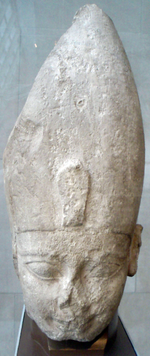 |
Successor to Kamose, above. | c.1550-1525 BCE; Radiocarbon date range for the start of his reign is 1570-1544 BCE, the mean point of which is 1557 BCE |
| Djeserkare Amenhotep I Amenhotep I Amenhotep I was the second Pharaoh of the 18th dynasty of Egypt. His reign is generally dated from 1526 to 1506 BC. He was born to Ahmose I and Ahmose-Nefertari, but had at least two elder brothers, Ahmose-ankh and Ahmose Sapair, and was not expected to inherit the throne... |
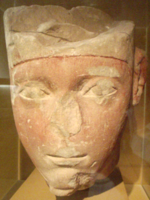 |
- | 1541-1520 |
| Aakheperkare Thutmose I Thutmose I Thutmose I was the third Pharaoh of the 18th dynasty of Egypt. He was given the throne after the death of the previous king Amenhotep I. During his reign, he campaigned deep into the Levant and Nubia, pushing the borders of Egypt further than ever before... |
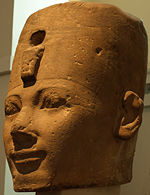 |
- | 1520-1492 |
| Aakheperenre Thutmose II Thutmose II Thutmose II was the fourth Pharaoh of the Eighteenth dynasty of Egypt. He built some minor monuments and initiated at least two minor campaigns but did little else during his rule and was probably strongly influenced by his wife, Hatshepsut... |
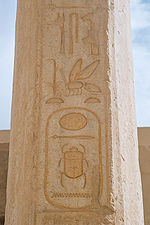 |
- | 1492-1479 |
| Menkheperre Thutmose III Thutmose III Thutmose III was the sixth Pharaoh of the Eighteenth Dynasty. During the first twenty-two years of Thutmose's reign he was co-regent with his stepmother, Hatshepsut, who was named the pharaoh... |
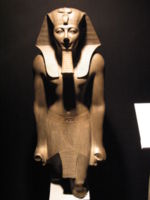 |
Often called the "Napoleon of Egypt." Dominated early in his reign by his stepmother Hatshepsut; after she died, he began expanding Egyptian rule into the Levant Levant The Levant or ) is the geographic region and culture zone of the "eastern Mediterranean littoral between Anatolia and Egypt" . The Levant includes most of modern Lebanon, Syria, Jordan, Israel, the Palestinian territories, and sometimes parts of Turkey and Iraq, and corresponds roughly to the... . |
1479-1425 |
| Maatkare Hatshepsut Hatshepsut Hatshepsut also Hatchepsut; meaning Foremost of Noble Ladies;1508–1458 BC) was the fifth pharaoh of the eighteenth dynasty of Ancient Egypt... |
 |
The second known female ruler, though quite possibly the seventh (the reigns of five other women are likely, but disputed). Recent evidence suggests she died of bone cancer. | 1473-1458 |
| Aakheperrure Amenhotep II Amenhotep II Amenhotep II was the seventh Pharaoh of the 18th dynasty of Egypt. Amenhotep inherited a vast kingdom from his father Thutmose III, and held it by means of a few military campaigns in Syria; however, he fought much less than his father, and his reign saw the effective cessation of hostilities... |
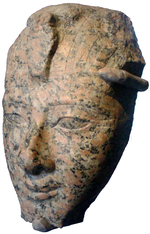 |
- | 1425-1400 |
| Menkheperure Thutmose IV Thutmose IV Thutmose IV was the 8th Pharaoh of the 18th dynasty of Egypt, who ruled in approximately the 14th century BC... |
 |
- | 1400-1390 |
| Nebmaatre Amenhotep III Amenhotep III Amenhotep III also known as Amenhotep the Magnificent was the ninth pharaoh of the Eighteenth dynasty. According to different authors, he ruled Egypt from June 1386 to 1349 BC or June 1388 BC to December 1351 BC/1350 BC after his father Thutmose IV died... The Magnificent King |
His name means Lord of the truth is Ra. He ruled Egypt at the peak of her glory, his mortuary temple was the largest ever built, but was destroyed by Rameses II to build his own temple. Recent DNA testing proved he was the Grandfather of Tutankhamun | 1390-1352 | |
| Neferkheperure-waenre Amenhotep IV/Akhenaten Akhenaten Akhenaten also spelled Echnaton,Ikhnaton,and Khuenaten;meaning "living spirit of Aten") known before the fifth year of his reign as Amenhotep IV , was a Pharaoh of the Eighteenth dynasty of Egypt who ruled for 17 years and died perhaps in 1336 BC or 1334 BC... |
 |
Founder of brief period of a solar-centered religion (Atenism Atenism Atenism, or the Amarna heresy, refers to the religious changes associated with the eighteenth dynasty Pharaoh Amenophis IV, better known under his adopted name, Akhenaten... ). His original name means "Amun Amun Amun, reconstructed Egyptian Yamānu , was a god in Egyptian mythology who in the form of Amun-Ra became the focus of the most complex system of theology in Ancient Egypt... is pleased." |
1352-1334 |
| Ankhkheperure Smenkhkare Smenkhkare Smenkhkare was an ephemeral Ancient Egyptian Pharaoh of the late Eighteenth Dynasty, of whom very little is known for certain... |
Co-regent and successor of Akhenaten. The identity of this individual is uncertain and disputed. Usually believed to be either a son or son-in-law of Akhenaten but sometimes identified as Akhenaten's wife Nefertiti Nefertiti Nefertiti was the Great Royal Wife of the Egyptian Pharaoh Akhenaten. Nefertiti and her husband were known for a religious revolution, in which they started to worship one god only... . Other scholars distinguish two individuals between Akhenaten and Tutankhamun, namely Smenkhkare, who is then seen as male, and a female ruler, who is then most often identified as Akhenaten's eldest daughter Meritaten Meritaten Meritaten also spelled Merytaten or Meryetaten was an ancient Egyptian queen of the eighteenth dynasty, who held the position of Great Royal Wife to Pharaoh Smenkhkare, who may have been a brother or son of Akhenaten... |
1334-1333 | |
| Nebkheperure Tutankhaten/Tutankhamun Tutankhamun Tutankhamun , Egyptian , ; approx. 1341 BC – 1323 BC) was an Egyptian pharaoh of the 18th dynasty , during the period of Egyptian history known as the New Kingdom... |
Commonly believed to be the son of Akhenaten, probably reinstated the polytheistic Polytheism Polytheism is the belief of multiple deities also usually assembled into a pantheon of gods and goddesses, along with their own mythologies and rituals.... religion and the name change reflects the change in primary deity from Aten to Amun. He is also known as the boy king. |
1333-1324 | |
| Kheperkheperure Ay Ay Ay was the penultimate Pharaoh of Ancient Egypt's 18th dynasty. He held the throne of Egypt for a brief four-year period , although he was a close advisor to two and perhaps three of the pharaohs who ruled before him and was the power behind the throne during Tutankhamun's reign... |
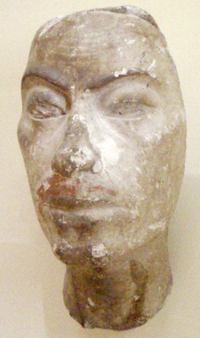 |
- | 1324-1320 |
| Djeserkheperure-setpenre Horemheb Horemheb Horemheb was the last Pharaoh of the 18th Dynasty from either 1319 BC to late 1292 BC, or 1306 to late 1292 BC although he was not related to the preceding royal family and is believed to have been of common birth.Before he became pharaoh, Horemheb was the commander in chief... |
 |
Former General and advisor to Tutankhamun Tutankhamun Tutankhamun , Egyptian , ; approx. 1341 BC – 1323 BC) was an Egyptian pharaoh of the 18th dynasty , during the period of Egyptian history known as the New Kingdom... . Obliterated images of the Amarna queens and kings (all except Amenhotep III and Tiye). |
1320-1292 |
Nineteenth Dynasty
The Nineteenth DynastyNineteenth dynasty of Egypt
The Nineteenth Dynasty of ancient Egypt was one of the periods of the Egyptian New Kingdom. Founded by Vizier Ramesses I, whom Pharaoh Horemheb chose as his successor to the throne, this dynasty is best known for its military conquests in Palestine, Lebanon, and Syria.The warrior kings of the...
ruled from 1292
1290s BC
-Events and trends:* c. 1295 BC–1186 BC–Great Temple of Amun, Karnak, is built. New Kingdom.* 1292 BC—End of the Eighteenth dynasty of Egypt, start of the Nineteenth Dynasty.* 1292 BC—The coronation of Ramses I....
to 1186 BC and includes one of the greatest pharaohs: Rameses II the Great:
| Name | Image | Comments | Dates |
|---|---|---|---|
| Menpehtire Ramesses I Ramesses I Menpehtyre Ramesses I was the founding Pharaoh of Ancient Egypt's 19th dynasty. The dates for his short reign are not completely known but the time-line of late 1292-1290 BC is frequently cited as well as 1295-1294 BC... |
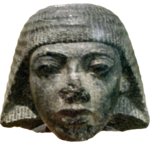 |
- | 1292-1290 |
| Menmaatre Seti I Seti I Menmaatre Seti I was a Pharaoh of Ancient Egypt , the son of Ramesses I and Queen Sitre, and the father of Ramesses II... |
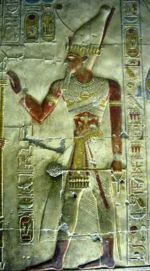 |
- | 1290-1279 |
| Usermaatre-setpenre Ramesses II Ramesses II Ramesses II , referred to as Ramesses the Great, was the third Egyptian pharaoh of the Nineteenth dynasty. He is often regarded as the greatest, most celebrated, and most powerful pharaoh of the Egyptian Empire... the Great |
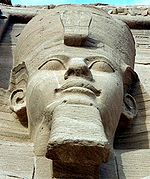 |
The ruler usually associated with Moses Moses Moses was, according to the Hebrew Bible and Qur'an, a religious leader, lawgiver and prophet, to whom the authorship of the Torah is traditionally attributed... ; he reached a stalemate Stalemate Stalemate is a situation in chess where the player whose turn it is to move is not in check but has no legal moves. A stalemate ends the game in a draw. Stalemate is covered in the rules of chess.... with the Hittites Hittites The Hittites were a Bronze Age people of Anatolia.They established a kingdom centered at Hattusa in north-central Anatolia c. the 18th century BC. The Hittite empire reached its height c... at the Battle of Kadesh Battle of Kadesh The Battle of Kadesh took place between the forces of the Egyptian Empire under Ramesses II and the Hittite Empire under Muwatalli II at the city of Kadesh on the Orontes River, in what is now the Syrian Arab Republic.... in 1275 BC, after which a peace treaty Peace treaty A peace treaty is an agreement between two or more hostile parties, usually countries or governments, that formally ends a state of war between the parties... was signed in 1258 BC |
1279-1213 |
| Banenre Merenptah Merneptah Merneptah was the fourth ruler of the Nineteenth Dynasty of Ancient Egypt. He ruled Egypt for almost ten years between late July or early August 1213 and May 2, 1203 BC, according to contemporary historical records... |
 |
A stele Merneptah Stele The Merneptah Stele — also known as the Israel Stele or Victory Stele of Merneptah — is an inscription by the Ancient Egyptian king Merneptah , which appears on the reverse side of a granite stele erected by the king Amenhotep III... describing campaigns in Libya Libya Libya is an African country in the Maghreb region of North Africa bordered by the Mediterranean Sea to the north, Egypt to the east, Sudan to the southeast, Chad and Niger to the south, and Algeria and Tunisia to the west.... and Canaan Canaan Canaan is a historical region roughly corresponding to modern-day Israel, Palestine, Lebanon, and the western parts of Jordan... contains the only extant reference to "Israel" in Ancient Egyptian records. |
1213-1203 |
| Menmire-setpenre Amenmesse |  |
- | 1203-1200 |
| Userkheperure Seti II Seti II Seti II , was the fifth ruler of the Nineteenth dynasty of Egypt and reigned from 1203 BC to 1197 BC. His throne name, Userkheperure Setepenre, meant "Powerful are the Manifestations of Re, Chosen by Re.' He was the son of Merneptah and wife Isisnofret and sat on the throne during a... |
 |
- | 1203-1197 |
| Sekhaenre/Akhenre Merenptah Siptah Siptah Akhenre Setepenre Siptah or Merneptah Siptah was the penultimate ruler of the 19th Dynasty. His father's identity is currently unknown. Both Seti II and Amenmesse have been suggested. He was not the crown prince, but succeeded to the throne as a child after the death of Seti II... |
 |
- | 1197-1191 |
| Satre-merenamun Tausret |  |
A rare female ruler also known as Tawosret in some places, she was probably the wife of Seti II. | 1191-1190 |
Twentieth Dynasty
The Twentieth DynastyTwentieth dynasty of Egypt
The Eighteenth, Nineteenth, and Twentieth Dynasties of ancient Egypt are often combined under the group title, New Kingdom. This dynasty is considered to be the last one of the New Kingdom of Egypt, and was followed by the Third Intermediate Period....
ruled from 1190 to 1077 BC:
| Name | Image | Comments | Dates |
|---|---|---|---|
| Userkhaure Setnakht Setnakhte Userkhaure-setepenre Setnakhte was the first Pharaoh of the Twentieth Dynasty of the New Kingdom of Ancient Egypt and the father of Ramesses III.... |
- | 1190-1186 | |
| Usermaatre-meryamun Ramesses III Ramesses III Usimare Ramesses III was the second Pharaoh of the Twentieth Dynasty and is considered to be the last great New Kingdom king to wield any substantial authority over Egypt. He was the son of Setnakhte and Queen Tiy-Merenese. Ramesses III is believed to have reigned from March 1186 to April 1155 BCE... |
Fought the Sea Peoples Sea Peoples The Sea Peoples were a confederacy of seafaring raiders of the second millennium BC who sailed into the eastern Mediterranean, caused political unrest, and attempted to enter or control Egyptian territory during the late 19th dynasty and especially during year 8 of Ramesses III of the 20th Dynasty... in 1175 BC |
1186-1155 | |
| User/Heqamaatre-setpenamun Ramesses IV Ramesses IV Heqamaatre Ramesses IV was the third pharaoh of the Twentieth Dynasty of the New Kingdom of Ancient Egypt. His name prior to assuming the crown was Amonhirkhopshef... |
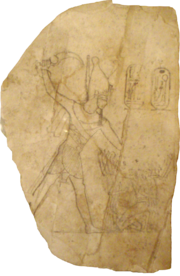 |
- | 1155-1149 |
| Usermaatre-sekheperenre Ramesses V Ramesses V Usermare Sekhepenre Ramesses V was the fourth pharaoh of the Twentieth dynasty of Egypt and was the son of Ramesses IV and Queen Duatentopet.- Reign :... |
- | 1149-1145 | |
| Nebmaatre-meryamun Ramesses VI Ramesses VI Ramesses VI was the fifth ruler of the Twentieth dynasty of Egypt who reigned from 1145 BC to 1137 BC and a son of Ramesses III by Iset Ta-Hemdjert... |
- | 1145-1137 | |
| Usermaatre-setpenre-meryamun Ramesses VII Ramesses VII Usermaatre Meryamun Setepenre Ramesses VII was the sixth pharaoh of the 20th dynasty of Ancient Egypt. He reigned from about 1136 to 1129 BC and was the son of Ramesses VI. Other dates for his reign are 1138-1131 BC... |
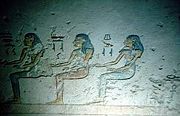 |
- | 1137-1130 |
| Usermaatre-akhenamun Ramesses VIII Ramesses VIII Usermare Akhenamun Ramesses VIII or Ramesses Sethherkhepshef Meryamun , was the seventh Pharaoh of the Twentieth Dynasty of the New Kingdom of Ancient Egypt and was one of the last surviving sons of Ramesses... |
 |
- | 1130-1129 |
| Neferkare-setpenre Ramesses IX Ramesses IX Ramesses IX was the eighth king of the Twentieth dynasty of Egypt. He was the third longest serving king of this Dynasty after Ramesses III and Ramesses XI... |
 |
- | 1129-1111 |
| Khepermaatre-setpenptah Ramesses X Ramesses X Khepermare Ramesses X was the ninth ruler of the 20th dynasty of Ancient Egypt. His birth name was Amonhirkhepeshef. It is uncertain if his reign was 3 or 4 Years, but there is now a strong consensus among Egyptologists that it did not last as long as 9 Years, as was previously assumed... |
- | 1111-1107 | |
| Menmaatre-setpenptah Ramesses XI Ramesses XI Ramesses XI reigned from 1107 BC to 1078 BC or 1077 BC and was the tenth and final king of the Twentieth dynasty of Egypt. He ruled Egypt for at least 29 years although some Egyptologists think he could have ruled for as long as 30... |
Ended rule sharing power with High Priest of Amun Herihor Herihor Herihor was an Egyptian army officer and High Priest of Amun at Thebes during the reign of Pharaoh Ramesses XI although Karl Jansen Winkeln has argued that Piankh preceded Herihor as High Priest at Thebes and that Herihor outlived Ramesses XI before being succeeded in this office by Pinedjem I,... ruling in the south and Smendes I ruling in the north, a period known as wehem mesut Whm Mswt The period of Ancient Egyptian history known as wehem mesut can be literally translated as Repetition of Births, but is usually referred to as the Era of the Renaissance. It began in about year 19 of the reign of Ramesses XI, around the end of the New Kingdom and the start of the Third... . |
1107-1077 |
Third Intermediate Period
The Third Intermediate Period (1077-732 BC) marked the end of the New Kingdom after the collapse of the Egyptian empire. A number of dynasties of LibyaLibya
Libya is an African country in the Maghreb region of North Africa bordered by the Mediterranean Sea to the north, Egypt to the east, Sudan to the southeast, Chad and Niger to the south, and Algeria and Tunisia to the west....
n origin ruled, giving this period its alternative name of the Libyan Period.
Twenty-First Dynasty
The Twenty-First DynastyTwenty-first dynasty of Egypt
The Twenty-First, Twenty-Second, Twenty-Third, Twenty-Fourth, and Twenty-Fifth Dynasties of ancient Egypt are often combined under the group title, Third Intermediate Period.-Rulers:...
was based at Tanis
Tanis, Egypt
Tanis , the Greek name of ancient Djanet , is a city in the north-eastern Nile delta of Egypt. It is located on the Tanitic branch of the Nile which has long since silted up.-History:...
and was a relatively weak group. Theoretically, they were rulers of all Egypt, but in practice their influence was limited to Lower Egypt. They ruled from 1069 to 943 BC
| Name | Image | Comments | Dates |
|---|---|---|---|
| Hedjkheperre-setpenre Nesbanebdjed | Also known as Smendes Smendes Hedjkheperre Setepenre Smendes was the founder of the Twenty-first dynasty of Egypt and succeeded to the throne after burying Ramesses XI in Lower Egypt – territory which he controlled... I |
1077-1051 | |
| Neferkare Heqawaset Amenemnisu Amenemnisu Neferkare Amenemnisu was a pharaoh during the 21st Dynasty of ancient Egypt.Amenemnisu's existence was only confirmed in 1940 when the tomb of his successor Psusennes I was discovered by Pierre Montet. A gold bow cap inscribed with both Amenemnisu's royal name, Neferkare, and that of his successor... |
- | 1051-1047 | |
| Aakheperre Pasebakhenniut I (Psusennes I) Psusennes I Psusennes I, or Greek Ψουσέννης], Pasibkhanu or Hor-Pasebakhaenniut I Egyptian ḥor-p3-sib3-ḫˁỉ--niwt] was the third king of the Twenty-first dynasty of Egypt who ruled from Tanis between 1047 – 1001 BC... |
- | 1047-1001 | |
| Usermaatre Amenemope |  |
- | 1001-992 |
| Aakheperre Setepenre Osorkon (Osorkon the Elder) Osorkon the Elder Akheperre Setepenre Osorkon the Elder was the fifth king of the twenty-first dynasty of Egypt and was the first pharaoh of Libyan extraction in Egypt... |
- * ( Osochor ) | 992-986 | |
| Netjerikheperre-setpenamun Siamun-meryamun Siamun Neterkheperre or Netjerkheperre-setepenamun Siamun was the sixth pharaoh of Egypt during the Twenty-first dynasty. He built extensively in Lower Egypt for a king of the Third Intermediate Period and is regarded as one of the most powerful rulers of this Dynasty after Psusennes I... |
- | 986-967 | |
| Titkheperure Pasebakhenniut II (Psusennes II) Psusennes II Titkheperure or Tyetkheperre Psusennes II Greek Ψουσέννης] or Hor-Pasebakhaenniut II Egyptian ḥr-p3-sb3-ḫˁỉ--nỉwt], was the last king of the Twenty-first dynasty of Egypt. His royal name means "Image of the transformation of Re" in Egyptian. Psusennes II is often considered the same person as... |
- | 967-943 |
Twenty-Second Dynasty
The pharaohs of the Twenty-Second DynastyTwenty-second dynasty of Egypt
The Twenty-First, Twenty-Second, Twenty-Third, Twenty-Fourth and Twenty-Fifth Dynasties of ancient Egypt are often combined under the group title, Third Intermediate Period.-Rulers:...
were Libya
Libya
Libya is an African country in the Maghreb region of North Africa bordered by the Mediterranean Sea to the north, Egypt to the east, Sudan to the southeast, Chad and Niger to the south, and Algeria and Tunisia to the west....
ns, ruling from around 943 to 720 BC:
| Name | Image | Comments | Dates |
|---|---|---|---|
| Hedjkheperre-setepenre Shoshenq I Shoshenq I Hedjkheperre Setepenre Shoshenq I , , also known as Sheshonk or Sheshonq I , was a Meshwesh Berber king of Egypt—of Libyan ancestry—and the founder of the Twenty-second Dynasty... |
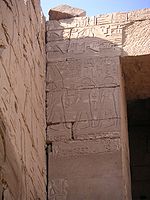 |
943-922 | |
| Sekhemkheperre Osorkon I Osorkon I The son of Shoshenq I and his chief consort, Karomat A, Osorkon I was the second king of Egypt's 22nd Dynasty and ruled around 922 BC – 887 BC. He succeeded his father Shoshenq I who probably died within a year of his successful 923 BC campaign against the kingdoms of Israel and Judah... |
- | 922-887 | |
| Heqakheperre Shoshenq II Shoshenq II Heqakheperre Shoshenq II was an Egyptian king of the 22nd dynasty of Egypt. He was the only ruler of this Dynasty whose tomb was not plundered by tomb robbers. His final resting place was discovered within Psusennes I's tomb at Tanis by Pierre Montet in 1939. Montet removed the coffin lid of... |
 |
- | 887-885 |
| Takelot I Takelot I Hedjkheperre Setepenre Takelot I was a son of Osorkon I and Queen Tashedkhons who ruled Egypt for 13 Years according to Manetho. Takelot would marry Queen Kapes who bore him Osorkon II... |
 |
- | 885-872 |
| Hedjkheperre Harsiese Harsiese A King Hedjkheperre Setepenamun Harsiese or Harsiese A, is viewed by the Egyptologist Kenneth Kitchen in his Third Intermediate Period in Egypt, to be both a "High Priest of Amun" and the son of the High Priest of Amun Shoshenq C. The archaeological evidence does suggest that he was indeed Shoshenq... |
 |
A rebel, at Thebes | 880-860 |
| Usermaatre-setepenamun Osorkon II Osorkon II Usermaatre Setepenamun Osorkon II was a pharaoh of the Twenty-second Dynasty of Ancient Egypt and the son of Takelot I and Queen Kapes. He ruled Egypt around 872 BC to 837 BC from Tanis, the capital of this Dynasty. After succeeding his father, he was faced with the competing rule of his cousin,... |
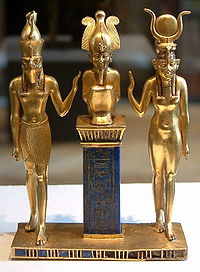 |
- | 872-837 |
| Usermaatre-setepenre Shoshenq III Shoshenq III King Usermaatre Setepenre or Usimare Setepenamun Shoshenq III ruled Egypt's 22nd Dynasty for 39 years according to contemporary historical records. Two Apis Bulls were buried in the fourth and 28th years of his reign and he celebrated his Heb Sed Jubilee in his regnal year 30... |
 |
- | 837-798 |
| Shoshenq IV Shoshenq IV Hedjkheperre Setepenre Shoshenq IV ruled Egypt's 22nd Dynasty between the reigns of Shoshenq III and Pami. This Pharaoh's existence was first argued by David Rohl but the British Egyptologist Aidan Dodson settled the issue in a seminal GM 137 article. Dodson's arguments here for the existence of a... |
- | 798-785 | |
| Usermaatre-setepenre Pami Pami Usermaatre Setepenre Pami was an Egyptian Pharaoh who ruled Egypt for 7 years. He was a member of the Twenty-second dynasty of Egypt of Meshwesh Libyans who had been living in the country since the Twentieth dynasty of Egypt when their ancestors infiltrated into the Egyptian Delta from Libya... |
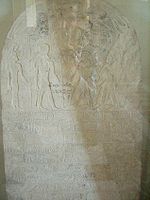 |
- | 785-778 |
| Aakheperre Shoshenq V Shoshenq V Shoshenq V was the final king of the Twenty-second dynasty of Egypt of Meshwesh Libyans which controlled Lower Egypt. He was the son of Pami according to a Year 11 Serapeum stela from his reign. His prenomen or throne name, Akheperre, means "Great is the Soul of Re."The burial of two Apis Bulls is... |
- | 778-740 | |
| Aakheperre-setepenamun Osorkon IV Osorkon IV Osorkon IV was a ruler of Lower Egypt who, while not always listed as a member of the Twenty-second dynasty of Egypt, he is attested as the ruler of Tanis--and thereby one of Shoshenq V's successors. Therefore he is sometimes listed as part of the dynasty, whether for convenience or in fact.His... |
- | 740-720 |
Twenty-Third Dynasty
The Twenty-Third DynastyTwenty-third dynasty of Egypt
The Twenty-third Dynasty of ancient Egypt was a separate regime of Meshwesh Libyan kings, who ruled ancient Egypt. This dynasty is often considered part of the Third Intermediate Period.-Rulers:...
was a local group, again of Libya
Libya
Libya is an African country in the Maghreb region of North Africa bordered by the Mediterranean Sea to the north, Egypt to the east, Sudan to the southeast, Chad and Niger to the south, and Algeria and Tunisia to the west....
n origin, based at Herakleopolis and Thebes that ruled from 837 to c.735 BC:
| Name | Image | Comments | Dates |
|---|---|---|---|
| Hedjkheperre-setpenre Takelot II Takelot II Hedjkheperre Setepenre Takelot II Si-Ese was a pharaoh of the Twenty-Third Dynasty of Ancient Egypt in Middle and Upper Egypt. He has been identified as the High Priest of Amun Takelot F, son of the High Priest of Amun Nimlot C at Thebes and, thus, the son of Nimlot C and grandson of king Osorkon... |
Previously thought to be a 22nd Dynasty pharaoh, he is now known to be the founder of the 23rd | 837-813 | |
| Usermaatre-setepenamun Pedubast | A rebel—seized Thebes Thebes, Egypt Thebes is the Greek name for a city in Ancient Egypt located about 800 km south of the Mediterranean, on the east bank of the river Nile within the modern city of Luxor. The Theban Necropolis is situated nearby on the west bank of the Nile.-History:... from Takelot II |
826-801 | |
| Usermaatre-setepenamun Iuput I Iuput I Iuput I was a Pharaoh of Ancient Egypt, who was a co-regent with his father, Pedubast I, near the beginning of the 23rd dynasty. The exact dates of his reign are unknown. It started possibly around 815 BC, or alternatively in the final couple of years of his father's reign; one authority provides... |
- | 812-811 | |
| Usermaatre Shoshenq VI Shoshenq VI Shoshenq VI is known to be Pedubast I's immediate successor at Thebes based upon the career of the Letter Writer to Pharaoh Hor IX, who served under Osorkon II and Pedubast I... |
Successor to Pedubast | 801-795 | |
| Usermaatre-setepenamun Osorkon III Osorkon III Usermaatre Setepenamun Osorkon III Si-Ese was Pharaoh of Egypt in the 8th Century BC. He is the same person as the Crown Prince and High Priest of Amun Osorkon B, son of Takelot II by his Great Royal Wife Karomama II. Prince Osorkon B is best attested by his Chronicle—which consists of a series of... |
Son of Takelot II- recovered Thebes, then proclaimed himself king | 795-767 | |
| Usermaatre-setpenamun Takelot III Takelot III Usimare Setepenamun Takelot III Si-Ese was Osorkon III's eldest son and successor. Takelot III ruled the first five years of his reign in a coregency with his father and served previously as the High Priest of Amun at Thebes. He was previously thought to have ruled Egypt for only 7 years until his... |
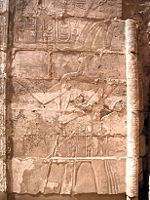 |
- | 773-765 |
| Usermaatre-setpenamun Rudamun Rudamun Rudamun was the final pharaoh of the Twenty-third dynasty of Ancient Egypt. His titulary simply reads as Usermaatre Setepenamun, Rudamun Meryamun, and excludes the Si-Ese or Netjer-Heqawaset epithets employed by his father and brother.... |
 |
- | 765-762 |
The Libu
Not recognised as a dynasty as such, the LibuLibu
The Libu were an ancient Berber tribe, from which the name Libya derives....
were yet another group of western nomads (Libya
Libya
Libya is an African country in the Maghreb region of North Africa bordered by the Mediterranean Sea to the north, Egypt to the east, Sudan to the southeast, Chad and Niger to the south, and Algeria and Tunisia to the west....
ns) who occupied the western Delta from 805 to 732 BC.
| Name | Image | Comments | Dates |
|---|---|---|---|
| Inamunnifnebu | - | 805-795 | |
| ? | - | 795-780 | |
| Niumateped | - | 780-755 | |
| Titaru | - | 763-755 | |
| Ker Ker (king) Ker was the king of the Libyans. His rule lasted from 750 BC to 745 BC.... |
- | 755-750 | |
| Rudamon | - | 750-745 | |
| Ankhor | - | 745-736 | |
| Tefnakht | - | 736-732 |
Twenty-Fourth Dynasty
The Twenty-fourth DynastyTwenty-fourth dynasty of Egypt
The Twenty-First, Twenty-Second, Twenty-Third, Twenty-Fourth and Twenty-Fifth Dynasties of ancient Egypt are often combined under the group title, Third Intermediate Period.-Rulers:...
was a short-lived rival dynasty located in the western Delta (Sais
Sais, Egypt
Sais or Sa el-Hagar was an ancient Egyptian town in the Western Nile Delta on the Canopic branch of the Nile. It was the provincial capital of Sap-Meh, the fifth nome of Lower Egypt and became the seat of power during the Twenty-fourth dynasty of Egypt and the Saite Twenty-sixth dynasty of Egypt ...
), with only two Pharaoh ruling from 732 to 720 BC.
| Name | Image | Comments | Dates |
|---|---|---|---|
| Shepsesre Tefnakhte Tefnakhte Shepsesre Tefnakht , was a prince of Saïs and founder of the relatively short Twenty-fourth dynasty of Egypt who rose to become a Chief of the Ma at his home city. He is thought to have reigned roughly 732 BCE - 725 BCE or 7 years... |
- | 732-725 | |
| Wahkare Bakenrenef (Bocchoris) | - | 725-720 |
Late period
The Late PeriodLate Period of Ancient Egypt
The Late Period of Ancient Egypt refers to the last flowering of native Egyptian rulers after the Third Intermediate Period from the 26th Saite Dynasty into Persian conquests and ended with the death of Alexander the Great...
runs from 732 BC to Egypt becoming a province of Rome
Ancient Rome
Ancient Rome was a thriving civilization that grew on the Italian Peninsula as early as the 8th century BC. Located along the Mediterranean Sea and centered on the city of Rome, it expanded to one of the largest empires in the ancient world....
in 30 BC
30 BC
Year 30 BC was either a common year starting on Wednesday, Thursday or Friday or a leap year starting on Thursday of the Julian calendar and a common year starting on Wednesday of the Proleptic Julian calendar...
, and includes periods of rule by Nubia
Nubia
Nubia is a region along the Nile river, which is located in northern Sudan and southern Egypt.There were a number of small Nubian kingdoms throughout the Middle Ages, the last of which collapsed in 1504, when Nubia became divided between Egypt and the Sennar sultanate resulting in the Arabization...
ns, Persians, and Macedon
Macedon
Macedonia or Macedon was an ancient kingdom, centered in the northeastern part of the Greek peninsula, bordered by Epirus to the west, Paeonia to the north, the region of Thrace to the east and Thessaly to the south....
ians.
Twenty-fifth Dynasty
NubiaNubia
Nubia is a region along the Nile river, which is located in northern Sudan and southern Egypt.There were a number of small Nubian kingdoms throughout the Middle Ages, the last of which collapsed in 1504, when Nubia became divided between Egypt and the Sennar sultanate resulting in the Arabization...
ns invaded Egypt in 732 BC and took the throne of Egypt, establishing the Twenty-fifth Dynasty
Twenty-fifth dynasty of Egypt
The twenty-fifth dynasty of Egypt, known as the Nubian Dynasty or the Kushite Empire, was the last dynasty of the Third Intermediate Period of Ancient Egypt....
which ruled until 656 BC.
| Name | Image | Comments | Dates |
|---|---|---|---|
| Usermaatre Piye Piye Piye, was a Kushite king and founder of the Twenty-fifth dynasty of Egypt who ruled Egypt from 747 BCE to 716 BCE according to Peter Clayton. He ruled from the city of Napata, located deep in Nubia, Sudan... |
King of Nubia Nubia Nubia is a region along the Nile river, which is located in northern Sudan and southern Egypt.There were a number of small Nubian kingdoms throughout the Middle Ages, the last of which collapsed in 1504, when Nubia became divided between Egypt and the Sennar sultanate resulting in the Arabization... ; conquered Egypt in 20th year; full reign at least 24 years, possibly 30+ years |
747-716 according to Peter Clayton | |
| Neferkare Shabaka Shabaka Shabaka or Shabaka Neferkare, 'Beautiful is the Soul of Re', was a Kushite pharaoh of the Twenty-fifth dynasty of Egypt, between according to Peter Clayton .-Family:... |
 |
- | 716-702 according to Peter Clayton |
| Djedkaure Shebitku Shebitku Shebitku was the third king of the Twenty-fifth dynasty of Egypt who ruled from 702 BCE to 690 BCE according to Peter Clayton or 707/706 BC-690 BC, according to Dan'el Kahn's most recent academic research. He was the nephew and successor of Shabaka. He was a son of Piye, the founder of this dynasty... |
 |
- | 702-690 according to Peter Clayton |
| Khuinefertemre Taharqa Taharqa Taharqa was a pharaoh of the Ancient Egyptian 25th dynasty and king of the Kingdom of Kush, which was located in Northern Sudan.Taharqa was the son of Piye, the Nubian king of Napata who had first conquered Egypt. Taharqa was also the cousin and successor of Shebitku. The successful campaigns of... |
 |
- | 690-664 |
| Bakare Tantamani Tantamani Tantamani or Tanwetamani or Tementhes was a Pharaoh of Egypt and the Kingdom of Kush located in Northern Sudan and a member of the Nubian or Twenty-fifth dynasty of Egypt... |
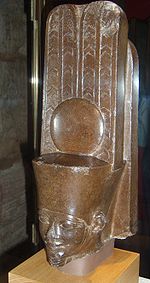 |
lost control of Upper Egypt in 656 BC when Psamtik I extended his authority into Thebes in that year. | 664-653 |
They were ultimately driven back into Nubia, where they established a kingdom at Napata
Napata
Napata was a city-state of ancient Nubia on the west bank of the Nile River, at the site of modern Karima, Northern Sudan.During the 8th to 7th centuries BC, Napata was the capital of the Nubian kingdom of Kush, whence the 25th, or Nubian Dynasty conquered Egypt...
(656-590), and, later, at Meroë
Meroë
Meroë Meroitic: Medewi or Bedewi; Arabic: and Meruwi) is an ancient city on the east bank of the Nile about 6 km north-east of the Kabushiya station near Shendi, Sudan, approximately 200 km north-east of Khartoum. Near the site are a group of villages called Bagrawiyah...
(590 BC-4th cent. AD).
Twenty-sixth Dynasty
The Twenty-sixth DynastyTwenty-sixth dynasty of Egypt
The Twenty-sixth Dynasty of Egypt was the last native dynasty to rule Egypt before the Persian conquest in 525 BC . The Dynasty's reign The Twenty-sixth Dynasty of Egypt (also written Dynasty XXVI or Dynasty 26) was the last native dynasty to rule Egypt before the Persian conquest in 525 BC...
ruled from around 672 to 525 BC.
| Name | Image | Comment | Dates |
|---|---|---|---|
| Menkheperre Nekau I (Necho I) Necho I Necho I was the prince or governor of the Egyptian city of Sais. He was the first attested local Saite king of the twenty-sixth dynasty of Egypt who reigned for 8 years, according to Manetho's Epitome. Egypt was reunified by his son, Psamtik I... |
- | 672 – 664 BC | |
| Wahibre Psamtik I (Psammetichus I) |  |
- | 664 – 610 BC |
| Wehemibre Necho II (Necho II) Necho II Necho II was a king of the Twenty-sixth dynasty of Egypt .Necho II is most likely the pharaoh mentioned in several books of the Bible . The Book of Kings states that Necho met King Josiah of the Kingdom of Judah at Megiddo and killed him... |
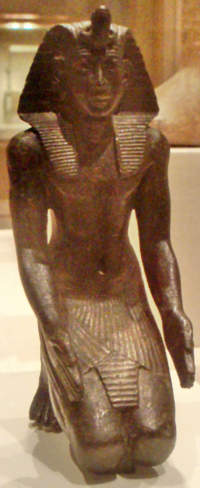 |
- | 610 – 595 BC |
| Neferibre Psamtik II (Psammetichus II) | - | 595 – 589 BC | |
| Haaibre Wahibre (Apries) | 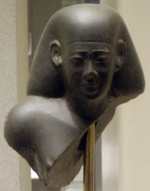 |
- | 589 – 570 BC |
| Khnemibre Ahmose II (Amasis) | 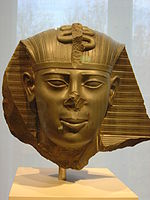 |
- | 570 – 526 BC |
| Ankhkaenre Psamtik III (Psammetichus III) | 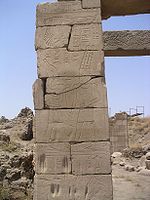 |
- | 526 – 525 BC |
Twenty-seventh Dynasty
Egypt was conquered by the Persian Empire in 525 BC and annexed by the Persians until 404 BC404 BC
Year 404 BC was a year of the pre-Julian Roman calendar. At the time, it was known as the Year of the Tribunate of Volusus, Cossus, Fidenas, Ambustus, Maluginensis and Rutilus...
. The Achaemenid shah
Shah
Shāh is the title of the ruler of certain Southwest Asian and Central Asian countries, especially Persia , and derives from the Persian word shah, meaning "king".-History:...
s were acknowledged as pharaohs in this era, forming a "Twenty-seventh" Dynasty
Twenty-seventh Dynasty of Egypt
The Twenty-seventh Dynasty of Egypt also known as the First Egyptian Satrapy was effectively a province of the Achaemenid Perisan Empire between 525 BCE to 402 BCE. The last pharaoh of the Twenty-Sixth dynasty, Psamtik III, was defeated by Cambyses II of Persia in the battle of Pelusium in the...
:
| Name | Image | Comments | Dates |
|---|---|---|---|
| Metsuire Cambyses (Cambyses II) | Defeated Psamtik III at the Battle of Pelusium Battle of Pelusium (525 BC) The Battle of Pelusium, was the first major battle between the Achaemenid Empire, and Egypt. This decisive battle transferred the throne of the Pharaohs to Cambyses II of Persia, king of the Persians. It was fought near Pelusium in 525 B.C.E... at 525 BC |
525 – 521 BC | |
| Smerdis (Bardiya) | Son of Cyrus the Great Cyrus the Great Cyrus II of Persia , commonly known as Cyrus the Great, also known as Cyrus the Elder, was the founder of the Achaemenid Empire. Under his rule, the empire embraced all the previous civilized states of the ancient Near East, expanded vastly and eventually conquered most of Southwest Asia and much... |
522 – 521 BC | |
| Setutre Darius I the Great |  |
- | 521 – 486 BC 486 BC Year 486 BC was a year of the pre-Julian Roman calendar. At the time, it was known as the Year of the Consulship of Viscellinus and Rutilus... |
| Xerxes I the Great | - | 486 486 BC Year 486 BC was a year of the pre-Julian Roman calendar. At the time, it was known as the Year of the Consulship of Viscellinus and Rutilus... – 465 BC 465 BC Year 465 BC was a year of the pre-Julian Roman calendar. At the time, it was known as the Year of the Consulship of Vibulanus and Barbatus... |
|
| Artabanus Artabanus of Persia Artabanus the Hyrcanian was a Persian political figure during the Achaemenid Dynasty who was reportedly Regent of Persia for a few months .... the Hyrcania Hyrcania Hyrcania was the name of a satrapy located in the territories of present day Gilan, Golestan, Mazandaran and part of Turkmenistan, lands south of the Caspian Sea. To the Greeks, the Caspian Sea was the "Hyrcanian Sea".-Etymology:... n |
- | 465 465 BC Year 465 BC was a year of the pre-Julian Roman calendar. At the time, it was known as the Year of the Consulship of Vibulanus and Barbatus... – 464 BC 464 BC Year 464 BC was a year of the pre-Julian Roman calendar. At the time, it was known as the Year of the Consulship of Albinus and Fusus... |
|
| Artaxerxes I Longhand | 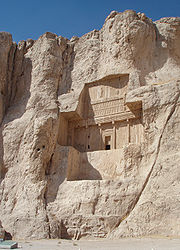 |
- | 464 464 BC Year 464 BC was a year of the pre-Julian Roman calendar. At the time, it was known as the Year of the Consulship of Albinus and Fusus... – 424 BC 424 BC Year 424 BC was a year of the pre-Julian Roman calendar. At the time, it was known as the Year of the Tribunate of Crassus, Fidenas, Rutilus and Iullus... |
| Xerxes II | claimant | 424 424 BC Year 424 BC was a year of the pre-Julian Roman calendar. At the time, it was known as the Year of the Tribunate of Crassus, Fidenas, Rutilus and Iullus... – 423 BC 423 BC Year 423 BC was a year of the pre-Julian Roman calendar. At the time, it was known as the Year of the Consulship of Atratinus and Ambustus... |
|
| Sogdianus | claimant | 424 424 BC Year 424 BC was a year of the pre-Julian Roman calendar. At the time, it was known as the Year of the Tribunate of Crassus, Fidenas, Rutilus and Iullus... – 423 BC 423 BC Year 423 BC was a year of the pre-Julian Roman calendar. At the time, it was known as the Year of the Consulship of Atratinus and Ambustus... |
|
| Darius II Darius II of Persia Darius II , was king of the Persian Empire from 423 BC to 405 BC.Artaxerxes I, who died on December 25, 424 BC, was followed by his son Xerxes II. After a month and a half Xerxes II was murdered by his brother Secydianus or Sogdianus... |
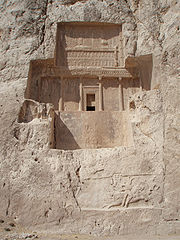 |
424 424 BC Year 424 BC was a year of the pre-Julian Roman calendar. At the time, it was known as the Year of the Tribunate of Crassus, Fidenas, Rutilus and Iullus... – 404 BC 404 BC Year 404 BC was a year of the pre-Julian Roman calendar. At the time, it was known as the Year of the Tribunate of Volusus, Cossus, Fidenas, Ambustus, Maluginensis and Rutilus... |
Twenty-eighth Dynasty
The Twenty-eighth DynastyTwenty-eighth dynasty of Egypt
The Twenty-Eighth Dynasty is often combined with other groupings of rulers of ancient Egypt under the title, Late Period. These other groupings include the Twenty-Sixth, Twenty-Seventh, Twenty-Ninth, Thirtieth, and Thirty-First dynasties.-Rulers:...
lasted only 6 years, from 404
404 BC
Year 404 BC was a year of the pre-Julian Roman calendar. At the time, it was known as the Year of the Tribunate of Volusus, Cossus, Fidenas, Ambustus, Maluginensis and Rutilus...
to 398 BC
398 BC
Year 398 BC was a year of the pre-Julian Roman calendar. At the time, it was known as the Year of the Tribunate of Potitus, Medullinus, Lactucinus, Fidenas, Camillus and Cornutus...
, with one Pharaoh:
| Name | Image | Comments | Dates |
|---|---|---|---|
| Amyrtaeus Amyrtaeus Amyrtaeus of Sais is the only king of the Twenty-eighth dynasty of Egypt and is thought to be related to the royal family of the Twenty-sixth dynasty... |
Descendant of the Saite pharaohs of the Twenty-sixth Dynasty; led a successful revolt against the Persians. | 404 404 BC Year 404 BC was a year of the pre-Julian Roman calendar. At the time, it was known as the Year of the Tribunate of Volusus, Cossus, Fidenas, Ambustus, Maluginensis and Rutilus... – 398 BC 398 BC Year 398 BC was a year of the pre-Julian Roman calendar. At the time, it was known as the Year of the Tribunate of Potitus, Medullinus, Lactucinus, Fidenas, Camillus and Cornutus... |
Twenty-ninth Dynasty
The Twenty-ninth DynastyTwenty-ninth dynasty of Egypt
Nepherites I founded the Twenty-ninth Dynasty of ancient Egypt by defeating Amyrtaeus in open battle, and later putting him to death at Memphis. Nepherites made his capital at Mendes...
ruled from 398
398 BC
Year 398 BC was a year of the pre-Julian Roman calendar. At the time, it was known as the Year of the Tribunate of Potitus, Medullinus, Lactucinus, Fidenas, Camillus and Cornutus...
to 380 BC
380 BC
Year 380 BC was a year of the pre-Julian Roman calendar. At the time, it was known as the Year of the Tribunate of Poplicola, Poplicola, Maluginensis, Lanatus, Peticus, Mamercinus, Fidenas, Crassus and Mugillanus...
:
| Name | Image | Comments | Dates |
|---|---|---|---|
| Baenre Nefaarud I Nefaarud I King Nepherites I, or Nefaarud I, founded the Twenty-ninth dynasty of Egypt by defeating Amyrtaeus in open battle, and then executing him at Memphis in the autumn of 399 BC. These events are recorded in an Aramaic papyrus document King Nepherites I, or Nefaarud I, founded the Twenty-ninth dynasty... |
 |
Also known as Nepherites | 398 398 BC Year 398 BC was a year of the pre-Julian Roman calendar. At the time, it was known as the Year of the Tribunate of Potitus, Medullinus, Lactucinus, Fidenas, Camillus and Cornutus... – 393 BC 393 BC Year 393 BC was a year of the pre-Julian Roman calendar. At the time, it was known as the Year of the Consulship of Poplicola and Cornelius... |
| Psammuthes Psammuthes Psammuthes was an Egyptian Pharaoh of the Twenty-ninth dynasty during 393 BC. Upon the death of Nepherites I, two rival factions fought for the throne: one supported Muthis son of Nefaarud, and the other supported an usurper named Psammuthes. Both men were, however, overcome by an unrelated man... |
 |
- | 393 BC 393 BC Year 393 BC was a year of the pre-Julian Roman calendar. At the time, it was known as the Year of the Consulship of Poplicola and Cornelius... |
| Khenemmaatre Hakor (Achoris) Hakor Hakor, or Akoris, was the Pharaoh of Egypt from 393 BC to 380 BC. Hakor overthrew his predecessor Psammuthes and falsely proclaimed himself to be the grandson of Nepherites I, founder of the 29th Dynasty, on his monuments in order to legitimise his kingship... |
 |
- | 393 393 BC Year 393 BC was a year of the pre-Julian Roman calendar. At the time, it was known as the Year of the Consulship of Poplicola and Cornelius... – 380 BC 380 BC Year 380 BC was a year of the pre-Julian Roman calendar. At the time, it was known as the Year of the Tribunate of Poplicola, Poplicola, Maluginensis, Lanatus, Peticus, Mamercinus, Fidenas, Crassus and Mugillanus... |
| Nefaarud II Nefaarud II Nepherities II or Nefaarud II became Pharaoh of Egypt in 380 BC after the death of his father Hakor. He was the last pharaoh of the twenty-ninth dynasty and the son of Hakor. He was deposed and likely killed by Nectanebo I after ruling Egypt for only 4 months.-References:... |
- | 380 BC 380 BC Year 380 BC was a year of the pre-Julian Roman calendar. At the time, it was known as the Year of the Tribunate of Poplicola, Poplicola, Maluginensis, Lanatus, Peticus, Mamercinus, Fidenas, Crassus and Mugillanus... |
Thirtieth Dynasty
The Thirtieth DynastyThirtieth dynasty of Egypt
The Thirtieth Dynasty of ancient Egypt followed Nectanebo I's deposition of Nefaarud II, the son of Hakor. This dynasty is often considered part of the Late Period....
ruled from 380
380 BC
Year 380 BC was a year of the pre-Julian Roman calendar. At the time, it was known as the Year of the Tribunate of Poplicola, Poplicola, Maluginensis, Lanatus, Peticus, Mamercinus, Fidenas, Crassus and Mugillanus...
until Egypt once more came under Persian rule in 343 BC
343 BC
Year 343 BC was a year of the pre-Julian Roman calendar. At the time it was known as the Year of the Consulship of Corvus and Arvina...
:
| Name | Image | Comments | Dates |
|---|---|---|---|
| Kheperkare Nekhtnebef (Nectanebo I) Nectanebo I Nectanabo was a pharaoh of the Thirtieth dynasty of Egypt.In 380 BC, Nectanebo deposed and killed Nefaarud II, starting the last dynasty of Egyptian kings. He seems to have spent much of his reign defending his kingdom from Persian reconquest with the occasional help of troops from Athens or Sparta... |
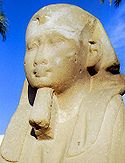 |
Also known as Nekhtnebef | 380 380 BC Year 380 BC was a year of the pre-Julian Roman calendar. At the time, it was known as the Year of the Tribunate of Poplicola, Poplicola, Maluginensis, Lanatus, Peticus, Mamercinus, Fidenas, Crassus and Mugillanus... – 362 BC 362 BC Year 362 BC was a year of the pre-Julian Roman calendar. At the time, it was known as the Year of the Consulship of Ahala and Aventinensis... |
| Irimaatenre Djedher (Teos) Teos of Egypt Teos or Tachos , Egyptian Djedhor, was Pharaoh of Egypt between the years of 362 to 360 BC; he had been co-regent with his father Nectanebo I from about 365. He was overthrown by Nectanebo II with the aid of Agesilaus II of Sparta and was forced to flee to Persia by way of Arabia... |
- | 362 362 BC Year 362 BC was a year of the pre-Julian Roman calendar. At the time, it was known as the Year of the Consulship of Ahala and Aventinensis... – 360 BC 360 BC Year 360 BC was a year of the pre-Julian Roman calendar. At the time, it was known as the Year of the Consulship of Ambustus and Visolus... |
|
| Senedjemibre Nakhthorhebyt (Nectanebo II) Nectanebo II Nectanebo II was the third and last pharaoh of the Thirtieth dynasty, as well as the last native ruler of Ancient Egypt. Under Nectanebo II Egypt prospered... |
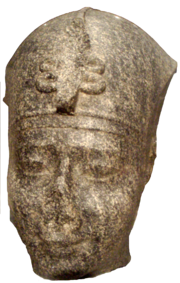 |
- | 360 360 BC Year 360 BC was a year of the pre-Julian Roman calendar. At the time, it was known as the Year of the Consulship of Ambustus and Visolus... – 343 BC 343 BC Year 343 BC was a year of the pre-Julian Roman calendar. At the time it was known as the Year of the Consulship of Corvus and Arvina... |
Thirty-first Dynasty
Egypt again came under the control of the Achaemenid Persians. After the practice of ManethoManetho
Manetho was an Egyptian historian and priest from Sebennytos who lived during the Ptolemaic era, approximately during the 3rd century BC. Manetho wrote the Aegyptiaca...
, the Persian rulers from 343
343 BC
Year 343 BC was a year of the pre-Julian Roman calendar. At the time it was known as the Year of the Consulship of Corvus and Arvina...
to 332 BC
332 BC
Year 332 BC was a year of the pre-Julian Roman calendar. At the time, it was known as the Year of the Consulship of Calvinus and Arvina...
are occasionally designated as the Thirty-first Dynasty
Thirty-first Dynasty of Egypt
The Thirtieth Dynasty of Egypt also known as the Second Egyptian Satrapy was effectively a short-living province of the Achaemenid Perisan Empire between 343 BCE to 332 BCE....
:
| Name | Image | Comments | Dates |
|---|---|---|---|
| Artaxerxes III | Egypt came under Persian rule for the second time | 343 343 BC Year 343 BC was a year of the pre-Julian Roman calendar. At the time it was known as the Year of the Consulship of Corvus and Arvina... –338 BC 338 BC Year 338 BC was a year of the pre-Julian Roman calendar. At the time it was known as the Year of the Consulship of Camillus and Maenius... |
|
| Artaxerxes IV Arses | Only reigned in Lower Egypt | 338 338 BC Year 338 BC was a year of the pre-Julian Roman calendar. At the time it was known as the Year of the Consulship of Camillus and Maenius... –336 BC 336 BC Year 336 BC was a year of the pre-Julian Roman calendar. At the time, it was known as the Year of the Consulship of Crassus and Duillius... |
|
| Khababash | Leader of a Nubian revolt in Upper Egypt | 338 338 BC Year 338 BC was a year of the pre-Julian Roman calendar. At the time it was known as the Year of the Consulship of Camillus and Maenius... –335 BC 335 BC Year 335 BC was a year of the pre-Julian Roman calendar. At the time, it was known as the Year of the Consulship of Calenus and Corvus... |
|
| Darius III Darius III of Persia Darius III , also known by his given name of Codomannus, was the last king of the Achaemenid Empire of Persia from 336 BC to 330 BC.... |
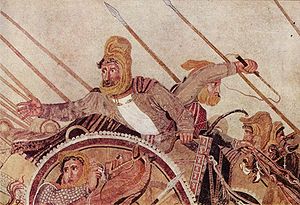 |
Upper Egypt returned to Persian control in 335 BC 335 BC Year 335 BC was a year of the pre-Julian Roman calendar. At the time, it was known as the Year of the Consulship of Calenus and Corvus... |
336 336 BC Year 336 BC was a year of the pre-Julian Roman calendar. At the time, it was known as the Year of the Consulship of Crassus and Duillius... –332 BC 332 BC Year 332 BC was a year of the pre-Julian Roman calendar. At the time, it was known as the Year of the Consulship of Calvinus and Arvina... |
Argead Dynasty
The MacedonMacedon
Macedonia or Macedon was an ancient kingdom, centered in the northeastern part of the Greek peninsula, bordered by Epirus to the west, Paeonia to the north, the region of Thrace to the east and Thessaly to the south....
ians under Alexander the Great ushered in the Hellenistic period with his conquest of Persia and Egypt. The Argeads
Argead dynasty
The Argead dynasty was an ancient Greek royal house. They were the ruling dynasty of Macedonia from about 700 to 310 BC. Their tradition, as described in ancient Greek historiography, traced their origins to Argos, in southern Greece...
ruled from 332
332 BC
Year 332 BC was a year of the pre-Julian Roman calendar. At the time, it was known as the Year of the Consulship of Calvinus and Arvina...
to 309 BC
309 BC
Year 309 BC was a year of the pre-Julian Roman calendar. At the time, it was known as the Year of the Dictatorship of Cursor...
:
| Name | Image | Comments | Dates |
|---|---|---|---|
| Setepenre-meryamun Alexander III (Alexander the Great) |  |
Macedon Macedon Macedonia or Macedon was an ancient kingdom, centered in the northeastern part of the Greek peninsula, bordered by Epirus to the west, Paeonia to the north, the region of Thrace to the east and Thessaly to the south.... conquered Persia and Egypt |
332 332 BC Year 332 BC was a year of the pre-Julian Roman calendar. At the time, it was known as the Year of the Consulship of Calvinus and Arvina... –323 BC 323 BC Year 323 BC was a year of the pre-Julian Roman calendar. At the time, it was known as the Year of the Consulship of Longus and Cerretanus... |
| Philip III Arrhidaeus Philip III of Macedon Philip III Arrhidaeus was the king of Macedonia from after June 11, 323 BC until his death. He was a son of King Philip II of Macedonia by Philinna of Larissa, allegedly a Thessalian dancer, and a half-brother of Alexander the Great... |
Feeble-minded half-brother of Alexander III the Great | 323 323 BC Year 323 BC was a year of the pre-Julian Roman calendar. At the time, it was known as the Year of the Consulship of Longus and Cerretanus... –317 BC 317 BC Year 317 BC was a year of the pre-Julian Roman calendar. At the time, it was known as the Year of the Consulship of Brutus and Barbula... |
|
| Haaibre Alexander IV Alexander IV of Macedon Alexander IV Aegus was the son of Alexander the Great and Princess Roxana of Bactria.-Birth:... |
Son of Alexander III the Great and Roxana Roxana Roxana sometimes Roxane, was a Bactrian noble and a wife of Alexander the Great. She was born earlier than the year 343 BC, though the precise date remains uncertain.... |
317 317 BC Year 317 BC was a year of the pre-Julian Roman calendar. At the time, it was known as the Year of the Consulship of Brutus and Barbula... –309 BC 309 BC Year 309 BC was a year of the pre-Julian Roman calendar. At the time, it was known as the Year of the Dictatorship of Cursor... |
Ptolemaic Dynasty
The second Hellenistic dynasty, the PtolemiesPtolemaic dynasty
The Ptolemaic dynasty, was a Macedonian Greek royal family which ruled the Ptolemaic Empire in Egypt during the Hellenistic period. Their rule lasted for 275 years, from 305 BC to 30 BC...
ruled Egypt from 305 BC
305 BC
Year 305 BC was a year of the pre-Julian Roman calendar. At the time, it was known as the Year of the Consulship of Megellus and Augurinus...
until Egypt became a province of Rome
Ancient Rome
Ancient Rome was a thriving civilization that grew on the Italian Peninsula as early as the 8th century BC. Located along the Mediterranean Sea and centered on the city of Rome, it expanded to one of the largest empires in the ancient world....
in 30 BC
30 BC
Year 30 BC was either a common year starting on Wednesday, Thursday or Friday or a leap year starting on Thursday of the Julian calendar and a common year starting on Wednesday of the Proleptic Julian calendar...
(whenever two dates overlap, that means there was a co-regency). The most famous member of this dynasty was Cleopatra VII, who in modern times is known simply as Cleopatra, and who had affairs with Mark Antony
Mark Antony
Marcus Antonius , known in English as Mark Antony, was a Roman politician and general. As a military commander and administrator, he was an important supporter and loyal friend of his mother's cousin Julius Caesar...
and Julius Caesar
Julius Caesar
Gaius Julius Caesar was a Roman general and statesman and a distinguished writer of Latin prose. He played a critical role in the gradual transformation of the Roman Republic into the Roman Empire....
.
| Name | Image | Comments | Dates |
|---|---|---|---|
| Ptolemy I Soter (Setepenre-meryamun Ptolemy) |  |
Abdicated in 285 BC 285 BC Year 285 BC was a year of the pre-Julian Roman calendar. At the time it was known as the Year of the Consulship of Canina and Lepidus... ; died in 283 BC 283 BC Year 283 BC was a year of the pre-Julian Roman calendar. At the time it was known as the Year of the Consulship of Dolabella and Maximus... |
305 305 BC Year 305 BC was a year of the pre-Julian Roman calendar. At the time, it was known as the Year of the Consulship of Megellus and Augurinus... –285 BC 285 BC Year 285 BC was a year of the pre-Julian Roman calendar. At the time it was known as the Year of the Consulship of Canina and Lepidus... |
| Berenice I Berenice I of Egypt Berenice I was a Greek Macedonian noblewoman and through her marriage to Ptolemy I Soter, became the first Queen of the Ptolemaic dynasty of Egypt.-Family:... |
Wife of Ptolemy I | ?-285 BC 285 BC Year 285 BC was a year of the pre-Julian Roman calendar. At the time it was known as the Year of the Consulship of Canina and Lepidus... |
|
| Ptolemy II Philadelphos (Weserkare-meryamun Ptolemy) | 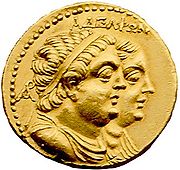 |
- | 288 288 BC Year 288 BC was a year of the pre-Julian Roman calendar. At the time it was known as the Year of the Consulship of Tremulus and Arvina... –246 BC 246 BC Year 246 BC was a year of the pre-Julian Roman calendar. At the time it was known as the Year of the Consulship of Crassus and Licinus... |
| Arsinoe I Arsinoe I of Egypt Arsinoe I was a Greek Princess who was of Macedonian and Thessalian descent. She was the second daughter and youngest child born to the diadochus who was King of Thrace, Asia Minor and Macedonia Lysimachus from his first wife the Queen consort, Nicaea of Macedon... |
Wife of Ptolemy II | 284 284 BC Year 284 BC was a year of the pre-Julian Roman calendar. At the time it was known as the Year of the Consulship of Tucca and Denter/Dentatus... /81 281 BC Year 281 BC was a year of the pre-Julian Roman calendar. At the time it was known as the Year of the Consulship of Barbula and Philippus... -ca. 274 BC 274 BC Year 274 BC was a year of the pre-Julian Roman calendar. At the time it was known as the Year of the Consulship of Dentatus and Merenda... |
|
| Arsinoe II Arsinoe II of Egypt For other uses see, ArsinoeArsinoë II was a Ptolemaic Greek Princess of Ancient Egypt and through marriage was of Queen Thrace, Asia Minor and Macedonia as wife of King Lysimachus and later co-ruler of Egypt with her brother-husband Ptolemy II Philadelphus For other uses see, ArsinoeArsinoë II... |
 |
Wife of Ptolemy II | 277 277 BC Year 277 BC was a year of the pre-Julian Roman calendar. At the time it was known as the Year of the Consulship of Rufinus and Brutus... -270 BC 270 BC Year 270 BC was a year of the pre-Julian Roman calendar. At the time it was known as the Year of the Consulship of Clepsina and Blasio... |
| Ptolemy III Euergetes I | 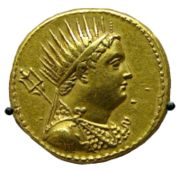 |
- | 246 246 BC Year 246 BC was a year of the pre-Julian Roman calendar. At the time it was known as the Year of the Consulship of Crassus and Licinus... –222 BC 222 BC Year 222 BC was a year of the pre-Julian Roman calendar. At the time it was known as the Year of the Consulship of Marcellus and Calvus... |
| Berenice II |  |
Wife of Ptolemy III | 244 244 BC Year 244 BC was a year of the pre-Julian Roman calendar. At the time it was known as the Year of the Consulship of Atticus and Blaesus... /3 243 BC Year 243 BC was a year of the pre-Julian Roman calendar. At the time it was known as the Year of the Consulship of Fundulus and Galus... -222 BC 222 BC Year 222 BC was a year of the pre-Julian Roman calendar. At the time it was known as the Year of the Consulship of Marcellus and Calvus... |
| Ptolemy IV Philopator | 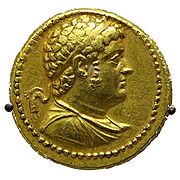 |
- | 222 222 BC Year 222 BC was a year of the pre-Julian Roman calendar. At the time it was known as the Year of the Consulship of Marcellus and Calvus... –204 BC 204 BC Year 204 BC was a year of the pre-Julian Roman calendar. At the time it was known as the Year of the Consulship of Cethegus and Tuditanus... |
| Arsinoe III Arsinoe III of Egypt Arsinoe III was Queen of Egypt . She was a daughter of Ptolemy III and Berenice II.Between late October and early November 220 BC she was married to her brother, Ptolemy IV. She took active part in the government of the country, at least in the measure that it was tolerated by the all-powerful... |
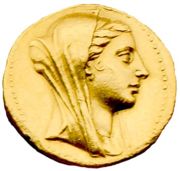 |
Wife of Ptolemy IV | 220 220 BC Year 220 BC was a year of the pre-Julian Roman calendar. At the time it was known as the Year of the Consulship of Laevinus/Catulus and Scaevola/Philo... -204 BC 204 BC Year 204 BC was a year of the pre-Julian Roman calendar. At the time it was known as the Year of the Consulship of Cethegus and Tuditanus... |
| Hugronaphor Hugronaphor Hugronaphor was an Upper Egyptian of apparently Nubian origin who led Upper Egypt in secession from the rule of Ptolemy IV Philopator in 205 BC... |
Revolutionary Pharaoh in the South | 205 205 BC Year 205 BC was a year of the pre-Julian Roman calendar. At the time it was known as the Year of the Consulship of Africanus and Dives... -199 BC 199 BC Year 199 BC was a year of the pre-Julian Roman calendar. At the time it was known as the Year of the Consulship of Lentulus and Tappulus... |
|
| Ankhmakis Ankhmakis Ankhmakis was the second Pharaoh of the rebel 35th dynasty, which controlled much of Upper Egypt during the reigns of Ptolemies IV and V... |
Revolutionary Pharaoh in the South | 199 199 BC Year 199 BC was a year of the pre-Julian Roman calendar. At the time it was known as the Year of the Consulship of Lentulus and Tappulus... -185 BC 185 BC Year 185 BC was a year of the pre-Julian Roman calendar. At the time it was known as the Year of the Consulship of Pulcher and Puditanus... |
|
| Ptolemy V Epiphanes |  |
Upper Egypt in revolt 207 207 BC Year 207 BC was a year of the pre-Julian Roman calendar. At the time it was known as the Year of the Consulship of Nero and Salinator... –186 BC 186 BC Year 186 BC was a year of the pre-Julian Roman calendar. At the time it was known as the Year of the Consulship of Albinus and Philippus... |
204 204 BC Year 204 BC was a year of the pre-Julian Roman calendar. At the time it was known as the Year of the Consulship of Cethegus and Tuditanus... –180 BC 180 BC Year 180 BC was a year of the pre-Julian Roman calendar. At the time it was known as the Year of the Consulship of Luscus and Piso/Flaccus... |
| Cleopatra I Cleopatra I of Egypt Cleopatra I Syra , c. 204–176 BC was a princess of the Seleucid Empire and by marriage, Queen of Ptolemaic Egypt.-Family:... |
Wife of Ptolemy V, co-regent with Ptolemy VI during his minority | 193 193 BC Year 193 BC was a year of the pre-Julian Roman calendar. At the time it was known as the Year of the Consulship of Merula and Thermus... -176 BC 176 BC Year 176 BC was a year of the pre-Julian Roman calendar. At the time it was known as the Year of the Consulship of Hispallus/Laevinus and Spurinus... |
|
| Ptolemy VI Philometor |  |
Died 145 BC 145 BC Year 145 BC was a year of the pre-Julian Roman calendar. At the time it was known as the Year of the Consulship of Ameilianus and Mancinus... |
180 180 BC Year 180 BC was a year of the pre-Julian Roman calendar. At the time it was known as the Year of the Consulship of Luscus and Piso/Flaccus... –164 BC 164 BC Year 164 BC was a year of the pre-Julian Roman calendar. At the time it was known as the Year of the Consulship of Torquatus and Longinus... |
| Cleopatra II Cleopatra II of Egypt Cleopatra II was a queen of Ptolemaic Egypt.-Family:Cleopatra II was the daughter of Ptolemy V and likely Cleopatra I. She was the sister of Ptolemy VI and Ptolemy VIII Euergetes II Tryphon. She would eventually marry both of her brothers.Her first marriage was with her brother Ptolemy VI in ca.... |
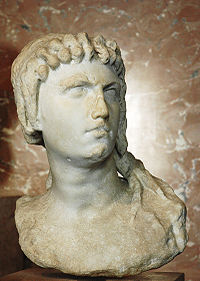 |
Wife of Ptolemy VI | 173 173 BC Year 173 BC was a year of the pre-Julian Roman calendar. At the time it was known as the Year of the Consulship of Albinus and Laenas... -164 BC 164 BC Year 164 BC was a year of the pre-Julian Roman calendar. At the time it was known as the Year of the Consulship of Torquatus and Longinus... |
| Ptolemy VIII Euergetes II |  |
Proclaimed king by Alexandria Alexandria Alexandria is the second-largest city of Egypt, with a population of 4.1 million, extending about along the coast of the Mediterranean Sea in the north central part of the country; it is also the largest city lying directly on the Mediterranean coast. It is Egypt's largest seaport, serving... ns in 170 BC 170 BC Year 170 BC was a year of the pre-Julian Roman calendar. At the time it was known as the Year of the Consulship of Mancinus and Serranus... ; ruled jointly with Ptolemy VI Philometor and Cleopatra II from 169 169 BC Year 169 BC was a year of the pre-Julian Roman calendar. At the time it was known as the Year of the Consulship of Philippus and Caepio... to 164 BC 164 BC Year 164 BC was a year of the pre-Julian Roman calendar. At the time it was known as the Year of the Consulship of Torquatus and Longinus... . Died 116 BC 116 BC Year 116 BC was a year of the pre-Julian Roman calendar. At the time it was known as the Year of the Consulship of Geta and Eburnus... |
171 171 BC Year 171 BC was a year of the pre-Julian Roman calendar. At the time it was known as the Year of the Consulship of Crassus and Longinus... –163 BC 163 BC Year 163 BC was a year of the pre-Julian Roman calendar. At the time it was known as the Year of the Consulship of Gracchus and Thalna... |
| Ptolemy VI Philometor |  |
Egypt under the control of Ptolemy VIII 164 BC 164 BC Year 164 BC was a year of the pre-Julian Roman calendar. At the time it was known as the Year of the Consulship of Torquatus and Longinus... –163 BC 163 BC Year 163 BC was a year of the pre-Julian Roman calendar. At the time it was known as the Year of the Consulship of Gracchus and Thalna... ; Ptolemy VI restored 163 BC 163 BC Year 163 BC was a year of the pre-Julian Roman calendar. At the time it was known as the Year of the Consulship of Gracchus and Thalna... |
163 163 BC Year 163 BC was a year of the pre-Julian Roman calendar. At the time it was known as the Year of the Consulship of Gracchus and Thalna... -145 BC 145 BC Year 145 BC was a year of the pre-Julian Roman calendar. At the time it was known as the Year of the Consulship of Ameilianus and Mancinus... |
| Cleopatra II Cleopatra II of Egypt Cleopatra II was a queen of Ptolemaic Egypt.-Family:Cleopatra II was the daughter of Ptolemy V and likely Cleopatra I. She was the sister of Ptolemy VI and Ptolemy VIII Euergetes II Tryphon. She would eventually marry both of her brothers.Her first marriage was with her brother Ptolemy VI in ca.... |
 |
Married Ptolemy VIII; led revolt against him in 131 BC 131 BC Year 131 BC was a year of the pre-Julian Roman calendar. At the time it was known as the Year of the Consulship of Mucianus and Flaccus... and became sole ruler of Egypt. |
163 163 BC Year 163 BC was a year of the pre-Julian Roman calendar. At the time it was known as the Year of the Consulship of Gracchus and Thalna... -127 BC 127 BC Year 127 BC was a year of the pre-Julian Roman calendar. At the time it was known as the Year of the Consulship of Ravilla and Cinna... |
| Ptolemy VII Neos Philopator | Proclaimed co-ruler by father; later ruled under regency of his mother Cleopatra II | 145 144 BC Year 144 BC was a year of the pre-Julian Roman calendar. At the time it was known as the Year of the Consulship of Galba and Cotta . The denomination 144 BC for this year has been used since the early medieval period, when the Anno Domini calendar era became the prevalent method in Europe for... -144 BC 144 BC Year 144 BC was a year of the pre-Julian Roman calendar. At the time it was known as the Year of the Consulship of Galba and Cotta . The denomination 144 BC for this year has been used since the early medieval period, when the Anno Domini calendar era became the prevalent method in Europe for... |
|
| Ptolemy VIII Euergetes II |  |
Restored | 145 145 BC Year 145 BC was a year of the pre-Julian Roman calendar. At the time it was known as the Year of the Consulship of Ameilianus and Mancinus... -131 BC 131 BC Year 131 BC was a year of the pre-Julian Roman calendar. At the time it was known as the Year of the Consulship of Mucianus and Flaccus... |
| Cleopatra III Cleopatra III of Egypt Cleopatra III was a queen of Egypt 142–101 BC.Cleopatra III was also known as Cleopatra Euergetis while associated with her husband Ptolemy VIII or her son Ptolemy X. She is attested as Cleopatra Philometor Soteira while associated with her eldest son Ptolemy IX... |
Second wife of Ptolemy VIII | 142 142 BC Year 142 BC was a year of the pre-Julian Roman calendar. At the time it was known as the Year of the Consulship of Calvus and Servilianus... -131 BC 131 BC Year 131 BC was a year of the pre-Julian Roman calendar. At the time it was known as the Year of the Consulship of Mucianus and Flaccus... |
|
| Ptolemy Memphitis | Proclaimed King by Cleopatra II; soon killed by Ptolemy VIII | 131 BC 131 BC Year 131 BC was a year of the pre-Julian Roman calendar. At the time it was known as the Year of the Consulship of Mucianus and Flaccus... |
|
| Ptolemy VIII Euergetes II |  |
Restored | 127 127 BC Year 127 BC was a year of the pre-Julian Roman calendar. At the time it was known as the Year of the Consulship of Ravilla and Cinna... -116 BC 116 BC Year 116 BC was a year of the pre-Julian Roman calendar. At the time it was known as the Year of the Consulship of Geta and Eburnus... |
| Cleopatra III Cleopatra III of Egypt Cleopatra III was a queen of Egypt 142–101 BC.Cleopatra III was also known as Cleopatra Euergetis while associated with her husband Ptolemy VIII or her son Ptolemy X. She is attested as Cleopatra Philometor Soteira while associated with her eldest son Ptolemy IX... |
Restored with Ptolemy VIII; later co-regent with Ptolemy IX and X. | 127 127 BC Year 127 BC was a year of the pre-Julian Roman calendar. At the time it was known as the Year of the Consulship of Ravilla and Cinna... -107 BC 107 BC Year 107 BC was a year of the pre-Julian Roman calendar. At the time it was known as the Year of the Consulship of Ravilla and Marius... |
|
| Cleopatra II Cleopatra II of Egypt Cleopatra II was a queen of Ptolemaic Egypt.-Family:Cleopatra II was the daughter of Ptolemy V and likely Cleopatra I. She was the sister of Ptolemy VI and Ptolemy VIII Euergetes II Tryphon. She would eventually marry both of her brothers.Her first marriage was with her brother Ptolemy VI in ca.... |
 |
Reconciled with Ptolemy VIII; co-ruled with Cleopatra III and Ptolemy until 116. | 124 124 BC Year 124 BC was a year of the pre-Julian Roman calendar. At the time it was known as the Year of the Consulship of Longinus and Calvinus... -116 BC 116 BC Year 116 BC was a year of the pre-Julian Roman calendar. At the time it was known as the Year of the Consulship of Geta and Eburnus... |
| Ptolemy IX Soter II |  |
Died 80 BC 80 BC Year 80 BC was a year of the pre-Julian Roman calendar. At the time it was known as the Year of the Consulship of Sulla and Metellus... |
116 116 BC Year 116 BC was a year of the pre-Julian Roman calendar. At the time it was known as the Year of the Consulship of Geta and Eburnus... –110 BC 110 BC Year 110 BC was a year of the pre-Julian Roman calendar. At the time it was known as the Year of the Consulship of Rufus and Albinus... |
| Cleopatra IV Cleopatra IV of Egypt Cleopatra IV was Queen of Egypt briefly from 116-115 BC, jointly with her husband Ptolemy IX Lathyros. She later became queen consort of Syria as the wife of Antiochus IX Cyzicenus.-Biography:... |
Shortly married to Ptolemy IX, but was pushed out by Cleopatra III | 116 116 BC Year 116 BC was a year of the pre-Julian Roman calendar. At the time it was known as the Year of the Consulship of Geta and Eburnus... -115 BC 115 BC Year 115 BC was a year of the pre-Julian Roman calendar. At the time it was known as the Year of the Consulship of Scaurus and Metellus... |
|
| Ptolemy X Alexander I | 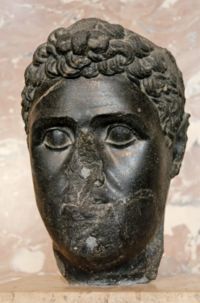 |
Died 88 BC 88 BC Year 88 BC was a year of the pre-Julian Roman calendar. At the time it was known as the Year of the Consulship of Sulla and Rufus... |
110 110 BC Year 110 BC was a year of the pre-Julian Roman calendar. At the time it was known as the Year of the Consulship of Rufus and Albinus... –109 BC 109 BC Year 109 BC was a year of the pre-Julian Roman calendar. At the time it was known as the Year of the Consulship of Numidicus and Silanus... |
| Berenice III Berenice III of Egypt Berenice III , sometimes called Cleopatra Berenice, ruled as queen of Egypt from 81 to 80 BC, and possibly from 101 to 88 BC jointly with her uncle/husband Ptolemy X Alexander I.... |
Forced to marry Ptolemy XI; murdered on his orders 19 days later | 81 81 BC Year 81 BC was a year of the pre-Julian Roman calendar. At the time it was known as the Year of the Consulship of Decula and Dolabella... -80 BC 80 BC Year 80 BC was a year of the pre-Julian Roman calendar. At the time it was known as the Year of the Consulship of Sulla and Metellus... |
|
| Ptolemy XI Alexander II | Young son of Ptolemy X Alexander; installed by Sulla; ruled for 80 days before being lynched by citizens for killing Berenice III | 80 BC 80 BC Year 80 BC was a year of the pre-Julian Roman calendar. At the time it was known as the Year of the Consulship of Sulla and Metellus... |
|
| Ptolemy XII Neos Dionysos (Auletes) |  |
Son of Ptolemy IX; died 51 BC 51 BC Year 51 BC was a year of the pre-Julian Roman calendar. At the time, it was known as the Year of the Consulship of Marcellus and Sulpicius... |
80 80 BC Year 80 BC was a year of the pre-Julian Roman calendar. At the time it was known as the Year of the Consulship of Sulla and Metellus... –58 BC 58 BC Year 58 BC was a year of the pre-Julian Roman calendar. At the time, it was known as the Year of the Consulship of Piso and Gabinius... |
| Cleopatra V Cleopatra V of Egypt Cleopatra V Tryphaena of Egypt was a Ptolemaic Queen of Egypt. She is the only surely attested wife of Ptolemy XII.-Descent and marriage:... Tryphaena |
Wife of Ptolemy XII, mother of Berenice IV | ?-57 BC 57 BC Year 57 BC was a year of the pre-Julian Roman calendar. At the time, it was known as the Year of the Consulship of Lentulus and Metellus... |
|
| Cleopatra VI Cleopatra VI of Egypt Cleopatra VI Tryphaena was an Egyptian Ptolemaic queen. She may be identical with Cleopatra V.There were at least two, perhaps three Ptolemaic women called Cleopatra Tryphaena:-Tryphaena, daughter of Ptolemy VIII Physcon and Cleopatra III:... |
Daughter of Ptolemy XII | ?-58 BC 58 BC Year 58 BC was a year of the pre-Julian Roman calendar. At the time, it was known as the Year of the Consulship of Piso and Gabinius... |
|
| Berenice IV Berenice IV of Egypt Berenice IV Epiphaneia born and died in Alexandria, Egypt. She was a Greek Princess of the Ptolemaic dynasty. Berenice was the daughter of Ptolemy XII Auletes and probably Cleopatra V Tryphaena, sister of the famous Cleopatra VII , Arsinoe IV, Ptolemy XIII and Ptolemy XIV. Berenice loved... |
Daughter of Ptolemy XII; forced to marry Seleucus Kybiosaktes, but has him strangled | 58 58 BC Year 58 BC was a year of the pre-Julian Roman calendar. At the time, it was known as the Year of the Consulship of Piso and Gabinius... –55 BC 55 BC Year 55 BC was a year of the pre-Julian Roman calendar. At the time, it was known as the Year of the Consulship of Crassus and Pompey... |
|
| Ptolemy XII Neos Dionysos |  |
Restored; reigned briefly with his daughter Cleopatra VII before his death | 55 55 BC Year 55 BC was a year of the pre-Julian Roman calendar. At the time, it was known as the Year of the Consulship of Crassus and Pompey... –51 BC 51 BC Year 51 BC was a year of the pre-Julian Roman calendar. At the time, it was known as the Year of the Consulship of Marcellus and Sulpicius... |
| Cleopatra VII | 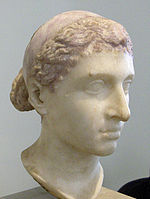 |
Jointly with her father Ptolemy XII, her brother Ptolemy XIII, her brother-husband Ptolemy XIV, and her son Ptolemy XV; also known simply as Cleopatra | 51 51 BC Year 51 BC was a year of the pre-Julian Roman calendar. At the time, it was known as the Year of the Consulship of Marcellus and Sulpicius... –30 BC 30 BC Year 30 BC was either a common year starting on Wednesday, Thursday or Friday or a leap year starting on Thursday of the Julian calendar and a common year starting on Wednesday of the Proleptic Julian calendar... |
| Ptolemy XIII | Brother of Cleopatra VII | 51 51 BC Year 51 BC was a year of the pre-Julian Roman calendar. At the time, it was known as the Year of the Consulship of Marcellus and Sulpicius... –47 BC 47 BC Year 47 BC was a year of the pre-Julian Roman calendar. At the time, it was known as the Year of the Consulship of Calenius and Vatinius... |
|
| Arsinoe IV Arsinoe IV of Egypt Arsinoë IV was the youngest daughter of Ptolemy XII Auletes, and one of the last members of the Ptolemaic dynasty of ancient Egypt... |
In opposition to Cleopatra VII | 48 48 BC Year 48 BC was a year of the pre-Julian Roman calendar. At the time, it was known as the Year of the Consulship of Caesar and Vatia... -47 BC 47 BC Year 47 BC was a year of the pre-Julian Roman calendar. At the time, it was known as the Year of the Consulship of Calenius and Vatinius... |
|
| Ptolemy XIV Ptolemy XIV of Egypt Ptolemy XIV , was a son of Ptolemy XII of Egypt and one of the last members of the Ptolemaic dynasty of Egypt. Following the death of his older brother Ptolemy XIII of Egypt on January 13, 47 BC, he was proclaimed Pharaoh and co-ruler by their older sister and remaining Pharaoh, Cleopatra VII of... |
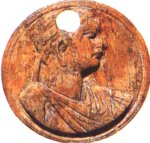 |
Younger brother of Cleopatra VII and Ptolemy XIII | 47 47 BC Year 47 BC was a year of the pre-Julian Roman calendar. At the time, it was known as the Year of the Consulship of Calenius and Vatinius... –44 BC 44 BC Year 44 BC was either a common year starting on Sunday or Monday or a leap year starting on Friday or Saturday of the Julian calendar and a common year starting on Sunday of the Proleptic Julian calendar... |
| Ptolemy XV | 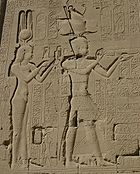 |
Infant son of Cleopatra VII; aged 3 when proclaimed co-ruler with Cleopatra. Last known ruler of ancient Egypt when Rome Rome Rome is the capital of Italy and the country's largest and most populated city and comune, with over 2.7 million residents in . The city is located in the central-western portion of the Italian Peninsula, on the Tiber River within the Lazio region of Italy.Rome's history spans two and a half... took over. |
44 44 BC Year 44 BC was either a common year starting on Sunday or Monday or a leap year starting on Friday or Saturday of the Julian calendar and a common year starting on Sunday of the Proleptic Julian calendar... -30 BC 30 BC Year 30 BC was either a common year starting on Wednesday, Thursday or Friday or a leap year starting on Thursday of the Julian calendar and a common year starting on Wednesday of the Proleptic Julian calendar... |
Rome
Cleopatra VII had affairAffair
Affair may refer to professional, personal, or public business matters or to a particular business or private activity of a temporary duration, as in family affair, a private affair, or a romantic affair.-Political affair:...
s with Roman Dictator Julius Caesar
Julius Caesar
Gaius Julius Caesar was a Roman general and statesman and a distinguished writer of Latin prose. He played a critical role in the gradual transformation of the Roman Republic into the Roman Empire....
and Roman General Marc Antony, but it was not until after her suicide in 30 BC (after Marc Antony was defeated by Octavian
Augustus
Augustus ;23 September 63 BC – 19 August AD 14) is considered the first emperor of the Roman Empire, which he ruled alone from 27 BC until his death in 14 AD.The dates of his rule are contemporary dates; Augustus lived under two calendars, the Roman Republican until 45 BC, and the Julian...
, who would later be the emperor Augustus) that Egypt became a province of Rome
Ancient Rome
Ancient Rome was a thriving civilization that grew on the Italian Peninsula as early as the 8th century BC. Located along the Mediterranean Sea and centered on the city of Rome, it expanded to one of the largest empires in the ancient world....
in 30 BC
30 BC
Year 30 BC was either a common year starting on Wednesday, Thursday or Friday or a leap year starting on Thursday of the Julian calendar and a common year starting on Wednesday of the Proleptic Julian calendar...
.
Subsequent Roman Emperors were accorded the title of Pharaoh, although exclusively while in Egypt. One Egyptian king-list lists the Roman Emperors as Pharaohs up to and including Decius
Decius
Trajan Decius , was Roman Emperor from 249 to 251. In the last year of his reign, he co-ruled with his son Herennius Etruscus until they were both killed in the Battle of Abrittus.-Early life and rise to power:...
. See the list of Roman emperors.
See also
- Conventional Egyptian chronologyConventional Egyptian chronologyThe Conventional Egyptian chronology represents the scholarly consensus on the chronology of the rulers of ancient Egypt, taking into account well accepted developments during the 20th century but not including any of the major revision proposals that have also been made in that time.All dates are...
- Egyptian chronologyEgyptian chronologyThe creation of a reliable chronology of Ancient Egypt is a task fraught with problems. While the overwhelming majority of Egyptologists agree on the outline and many of the details of a common chronology, disagreements either individually or in groups have resulted in a variety of dates offered...
- History of EgyptHistory of EgyptEgyptian history can be roughly divided into the following periods:*Prehistoric Egypt*Ancient Egypt**Early Dynastic Period of Egypt: 31st to 27th centuries BC**Old Kingdom of Egypt: 27th to 22nd centuries BC...
- Lists of office-holders
- The Greatest PharaohsThe Greatest PharaohsThe Greatest Pharaohs is a 1997 American educational documentary film about Ancient Egypt distributed by A&E and narrated by Frank Langella with commentary by experts in the field...
External links
- Egyptian Royal Genealogy
- Manetho and the King Lists Review of different primary king lists
- Problems with Manetho's "Reign of the Gods" Page with different versions of god king lists
- Chronology Table - 0 Dynasty&History Period, by Dariusz Sitek Multi-pages of list of pharaohs in different king lists, without the god kings, in Egyptian hieroglyphs and English
- Egyptian Journey 2003: History: King Lists Hyperlink texts of the Manetho, Abydos & Turin king lists, without the god-kings
- Digital Egypt for Universities
- Ancient Egyptian papyrus collection and stories behind each scene, Egyptian museum masterpieces reproductions
- List of all female Pharaohs

